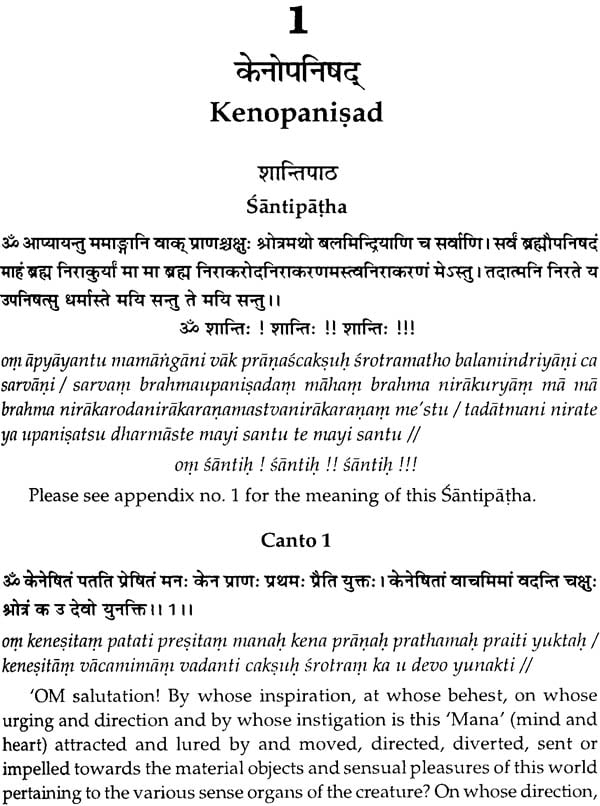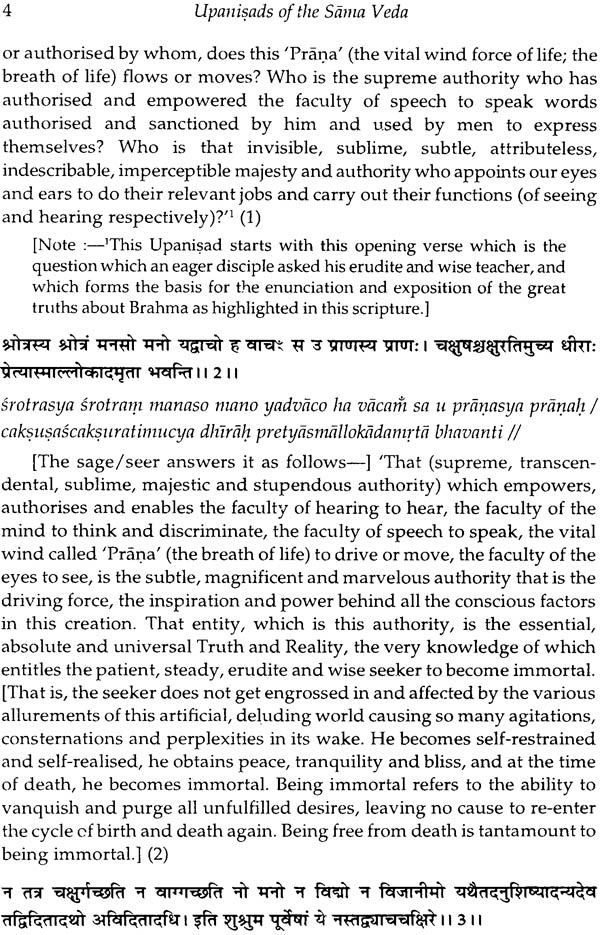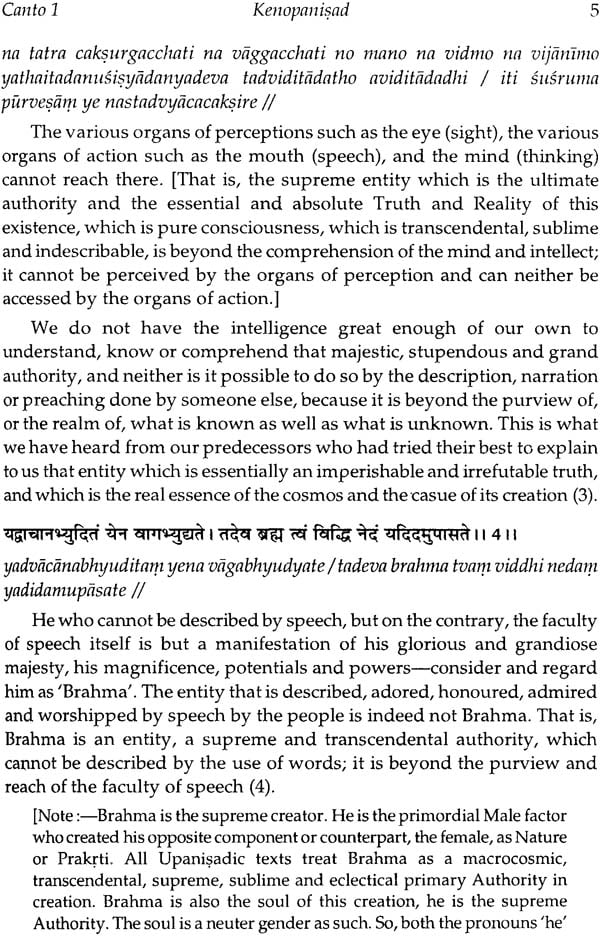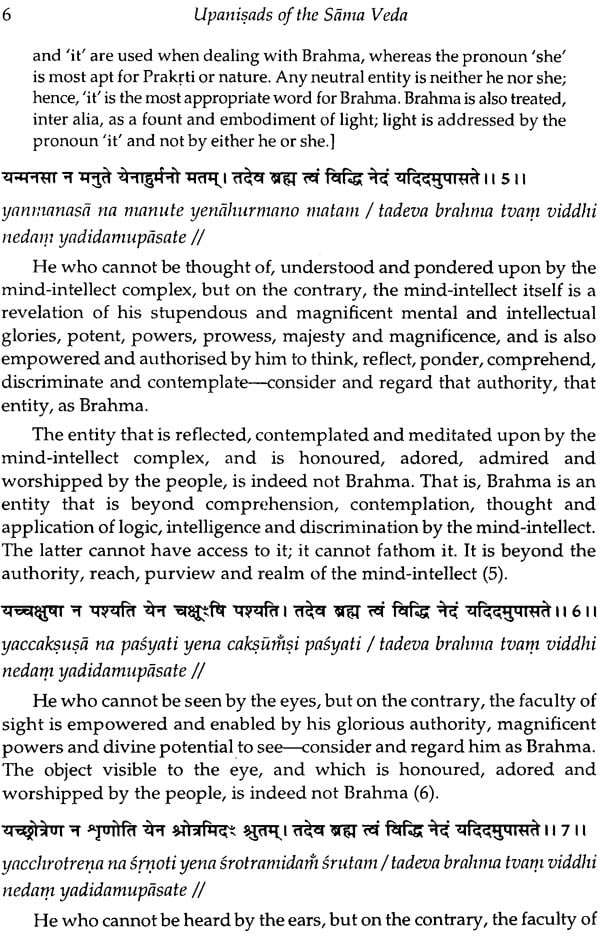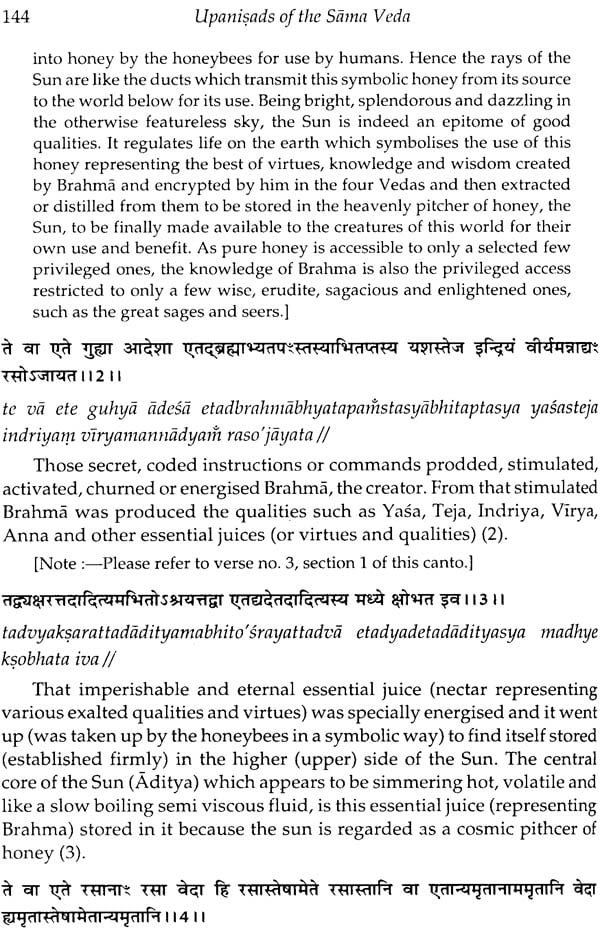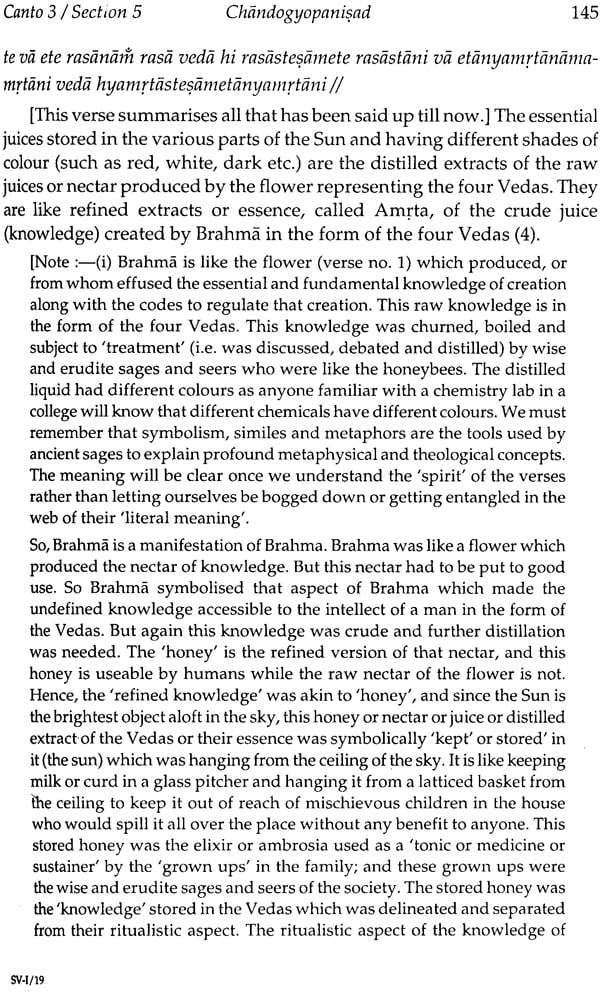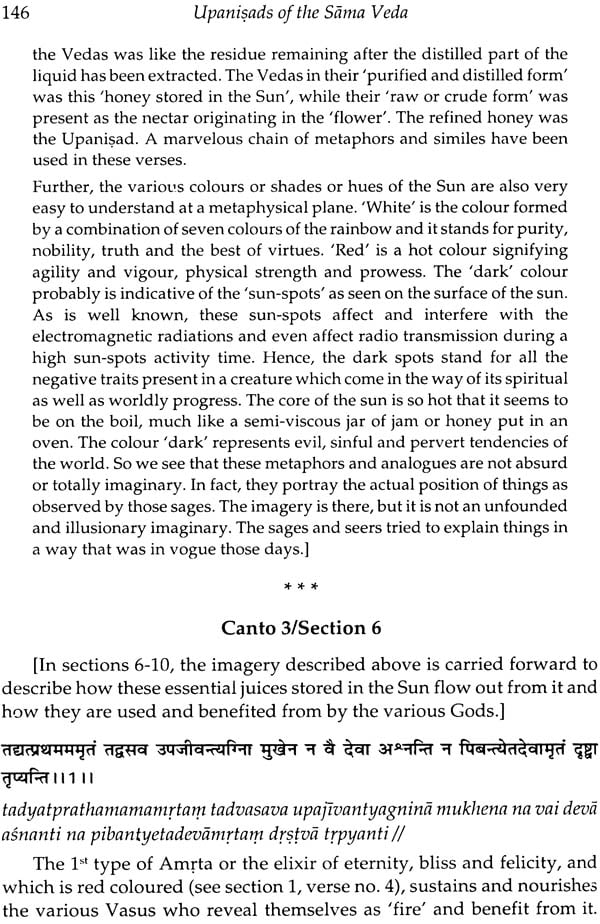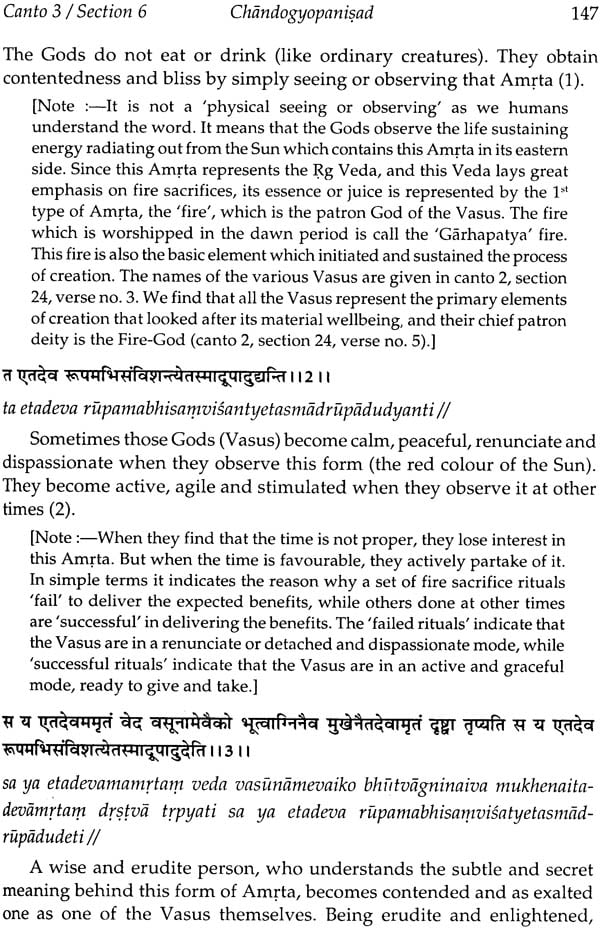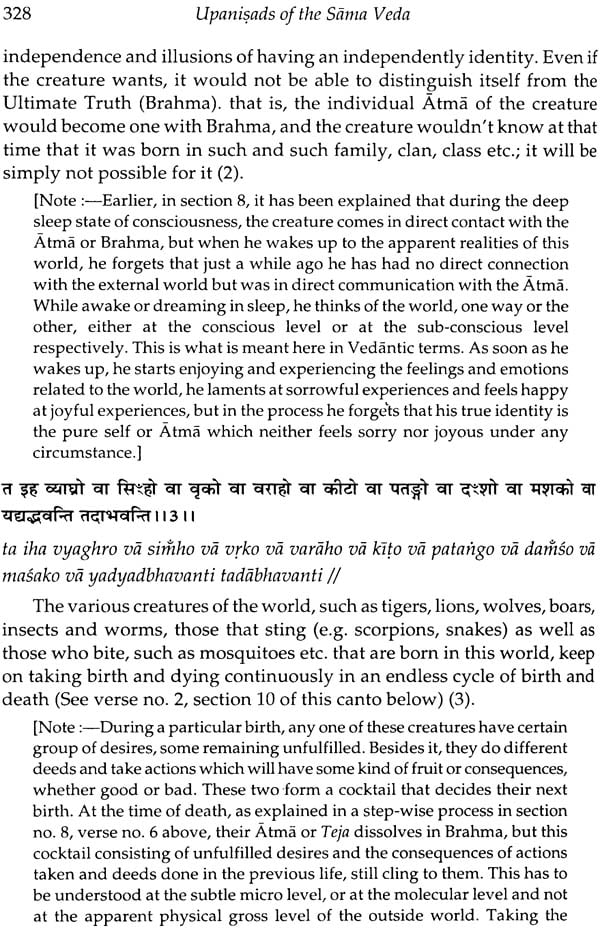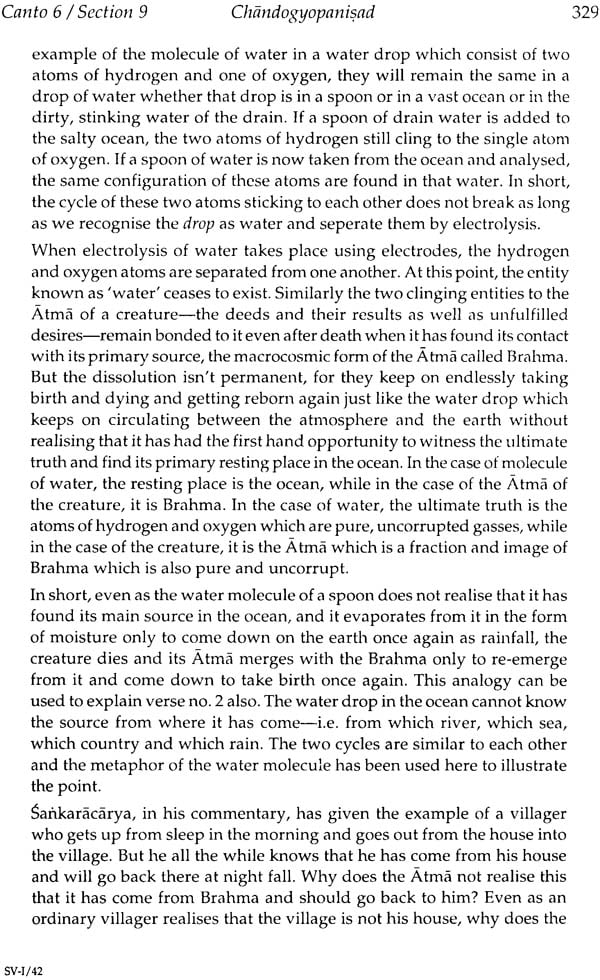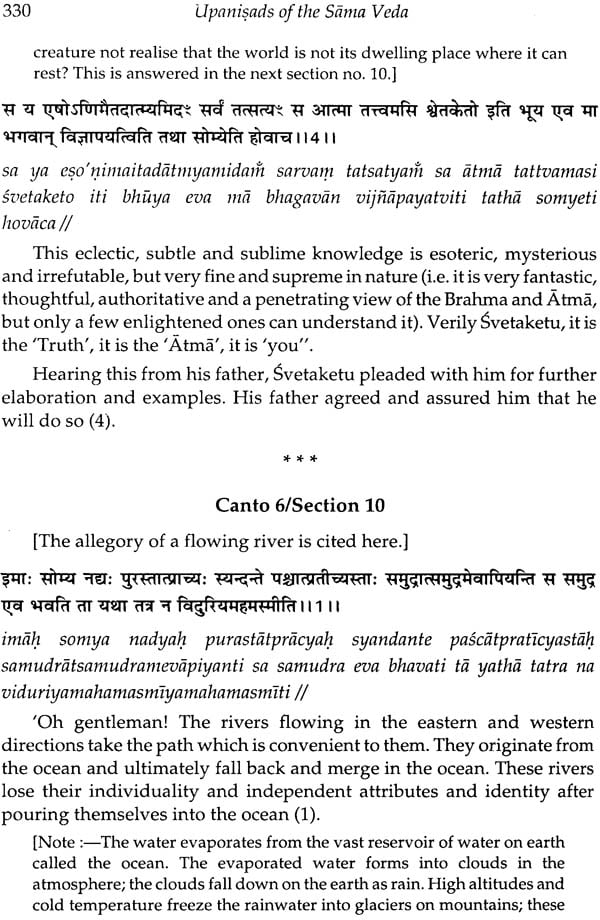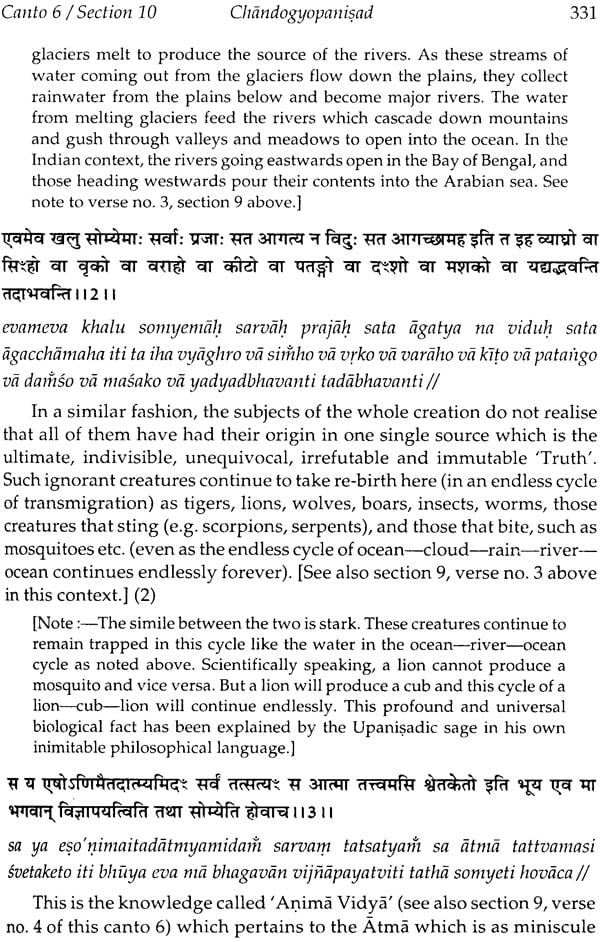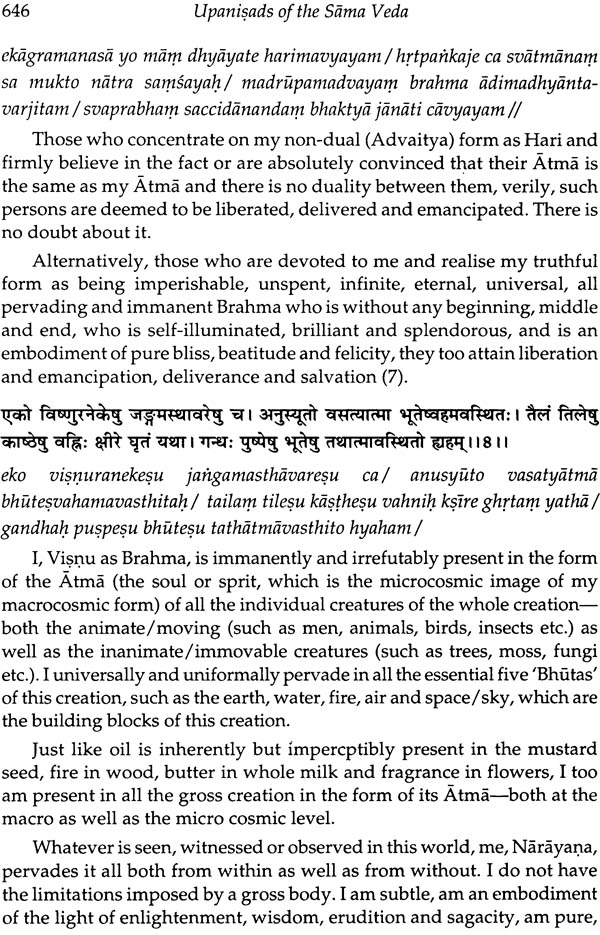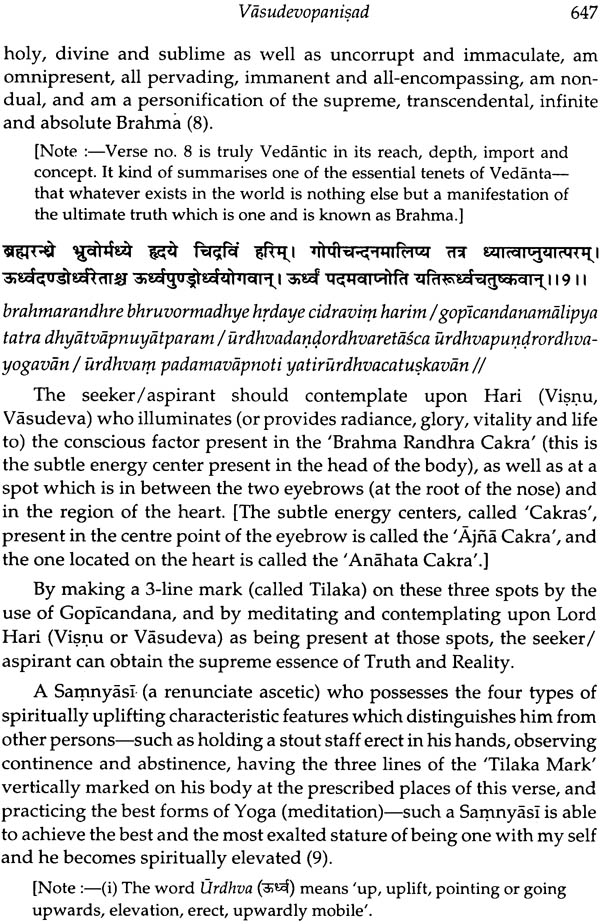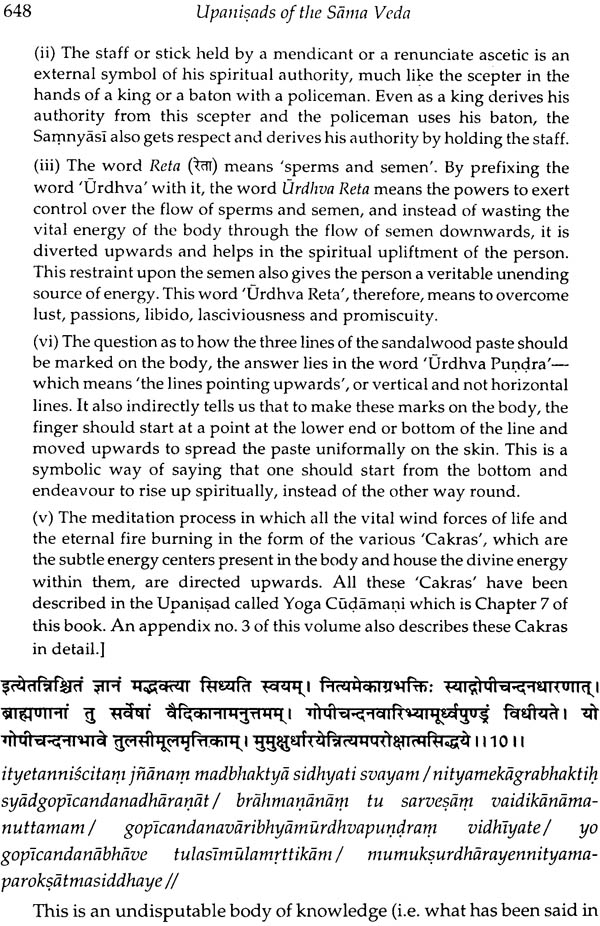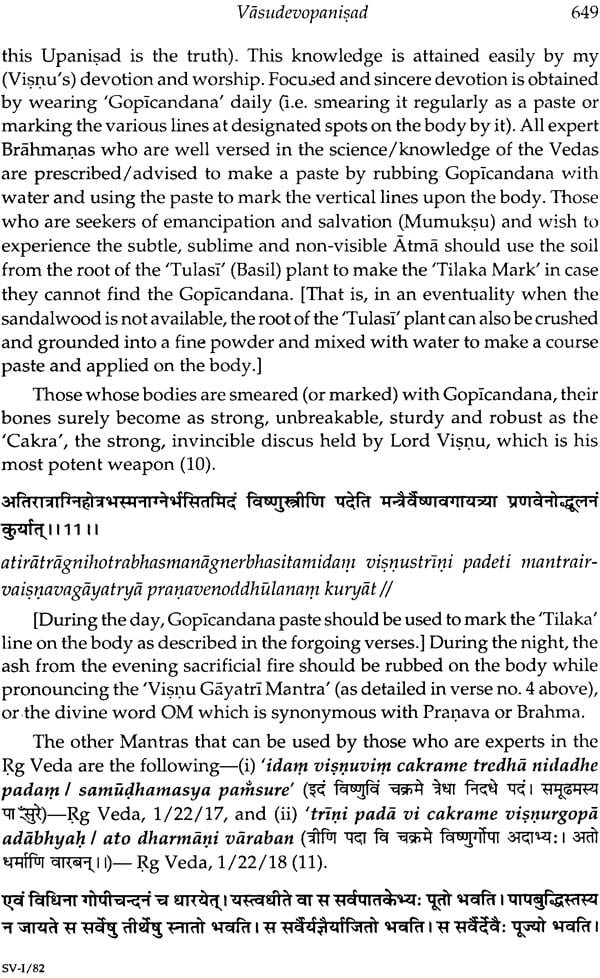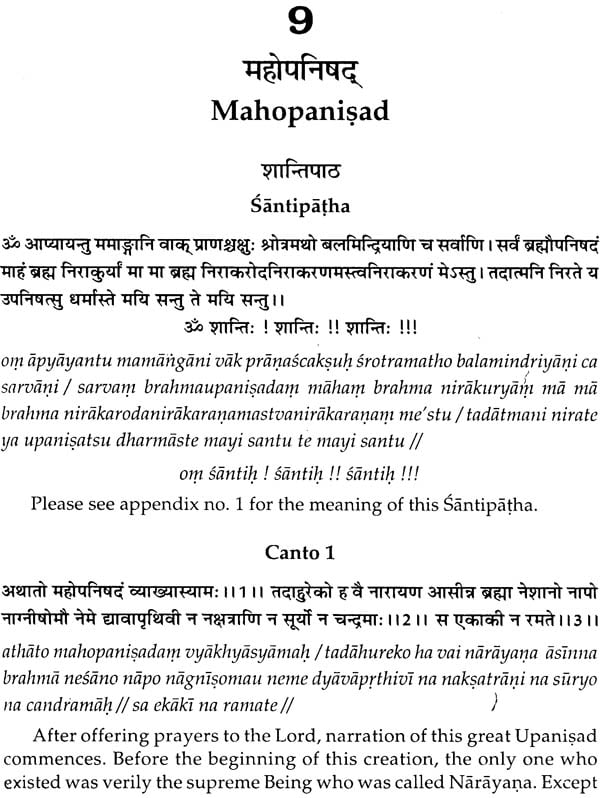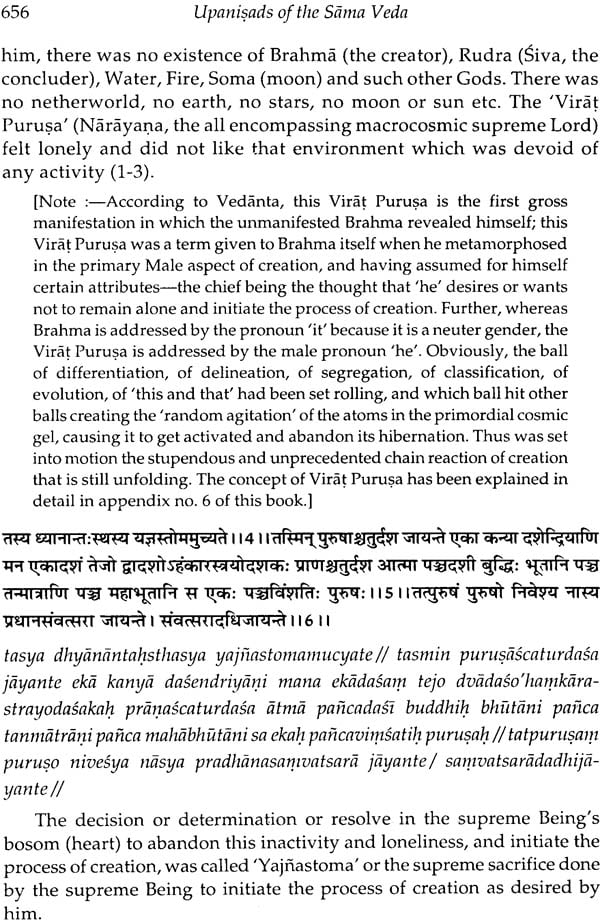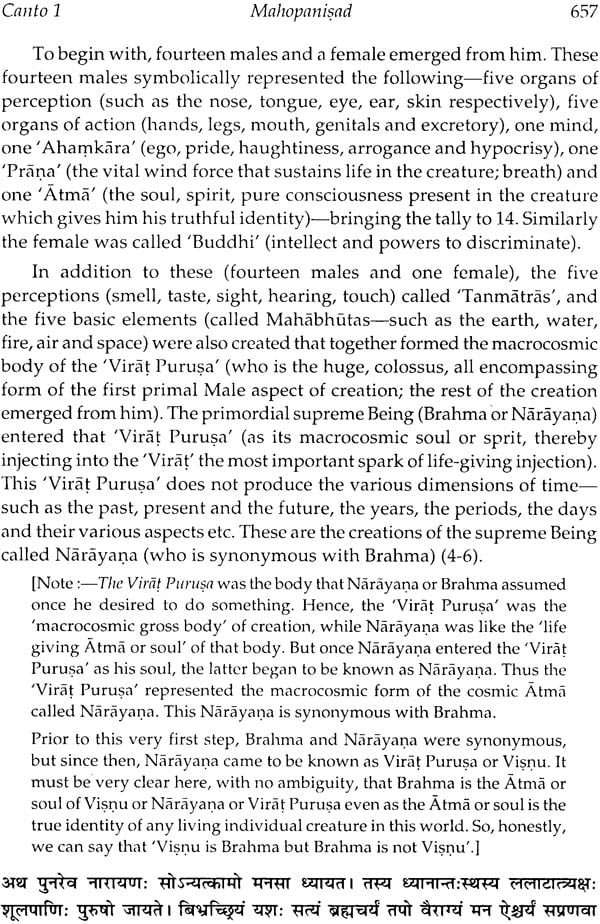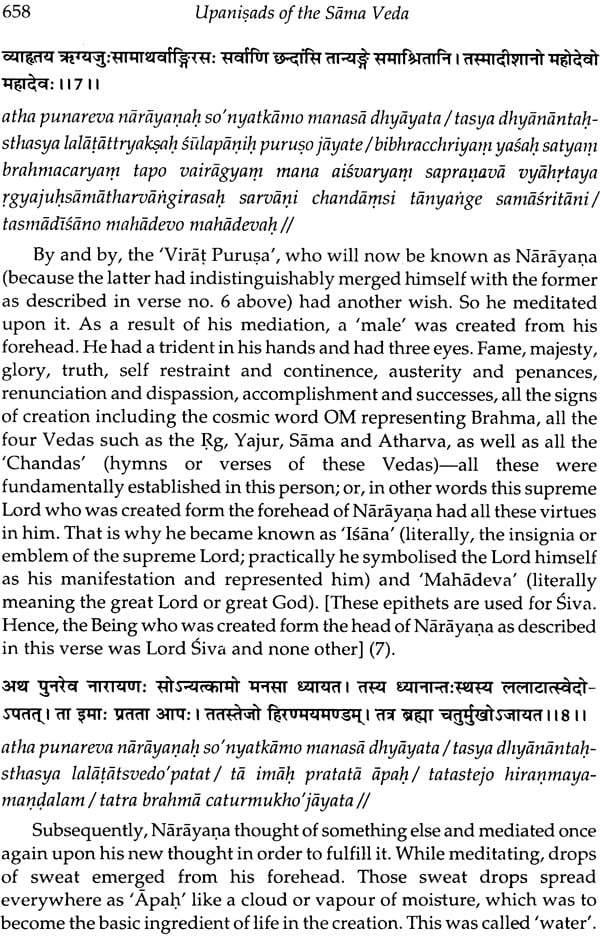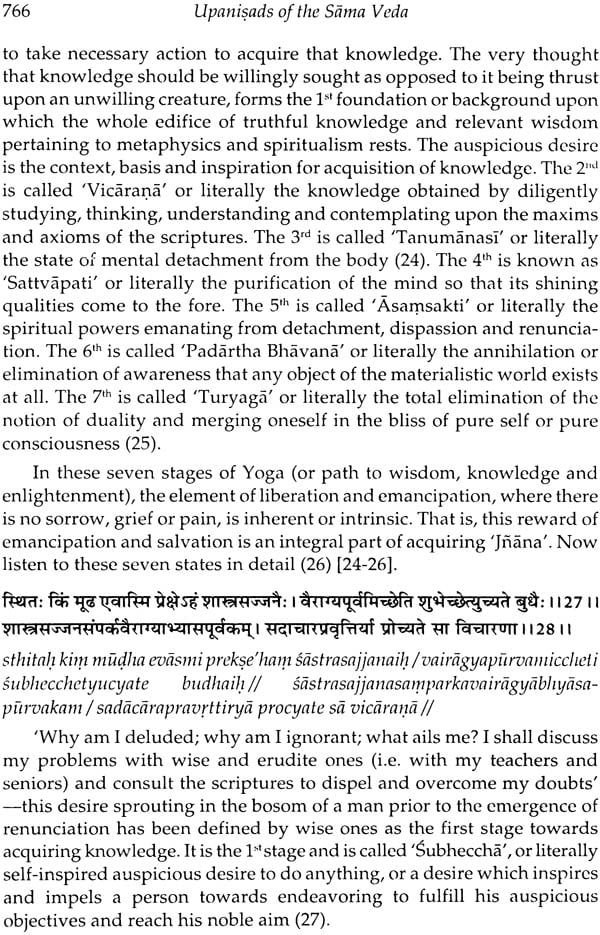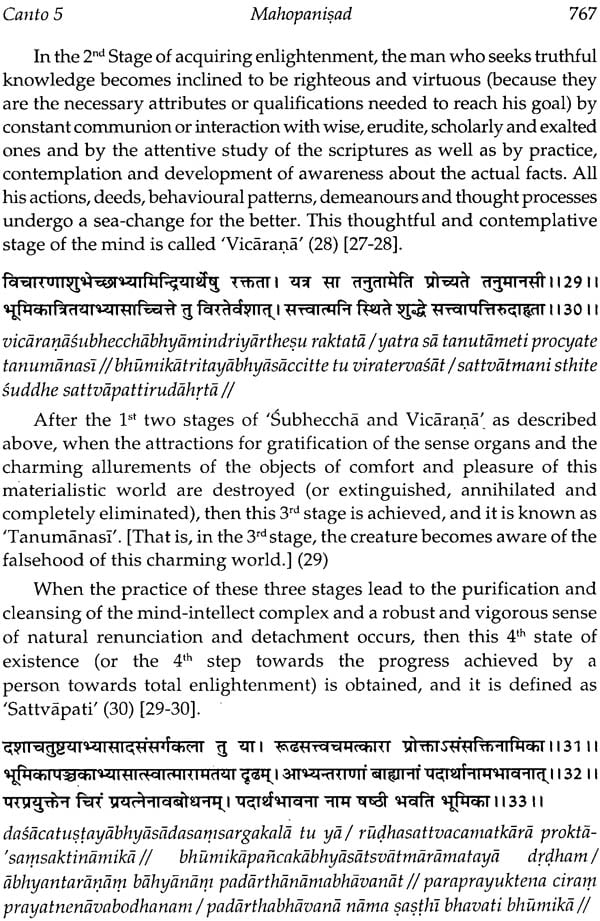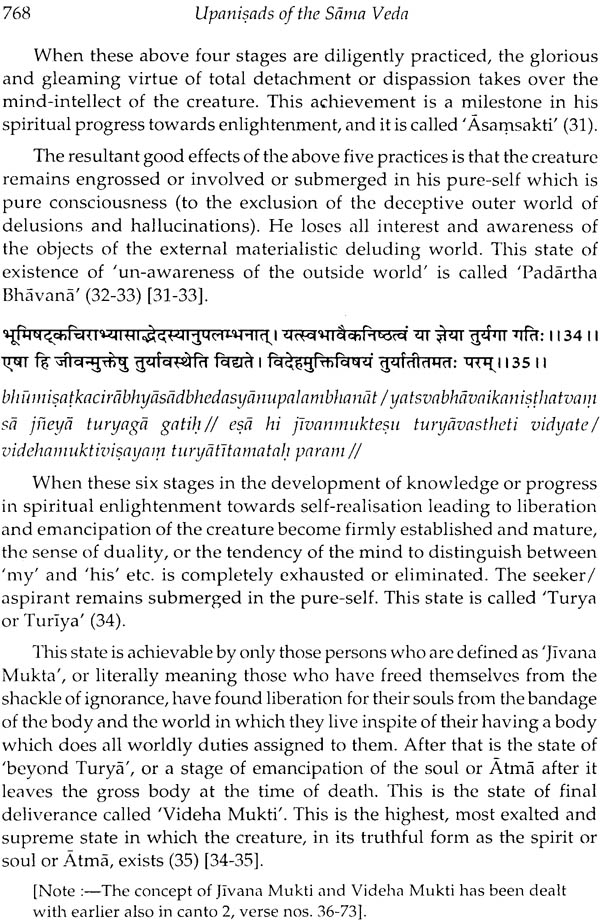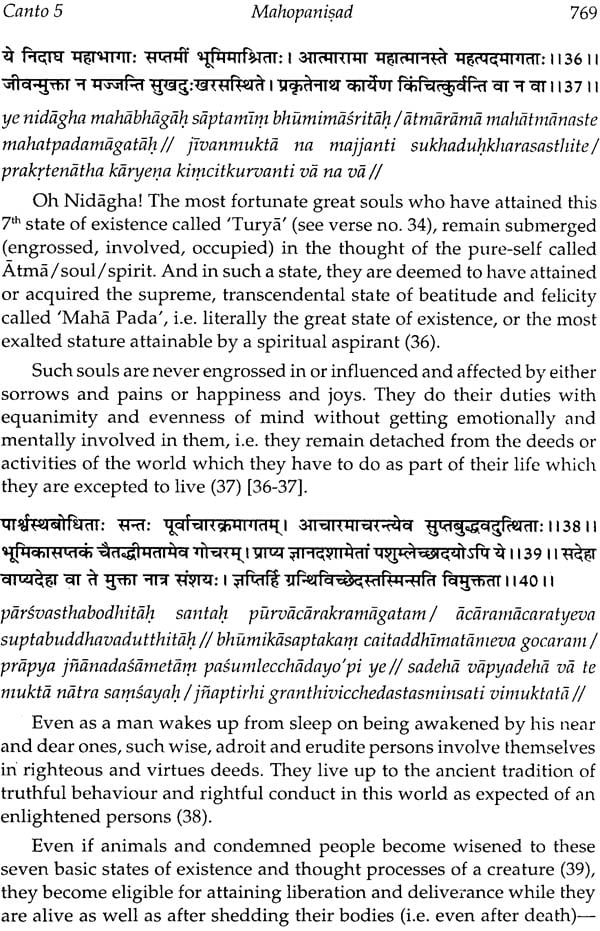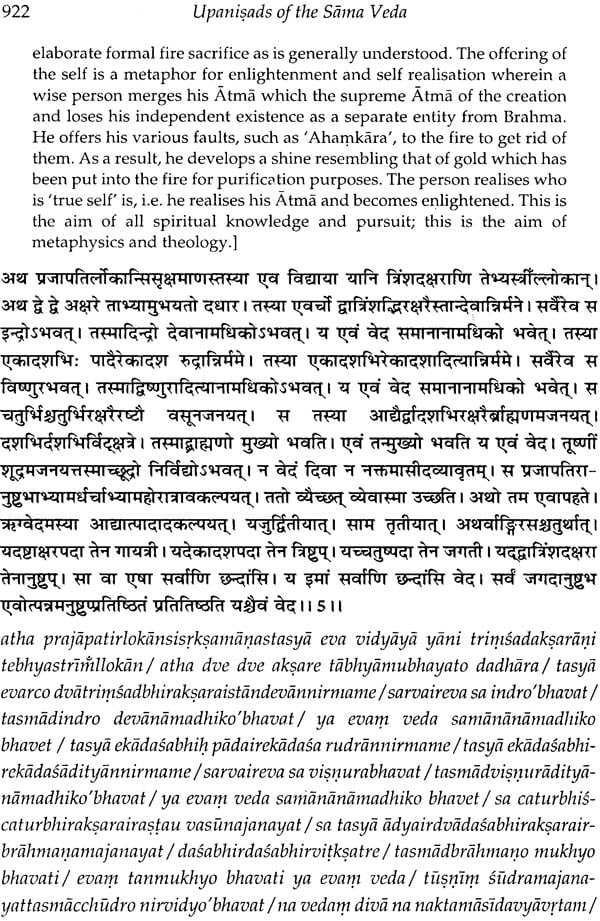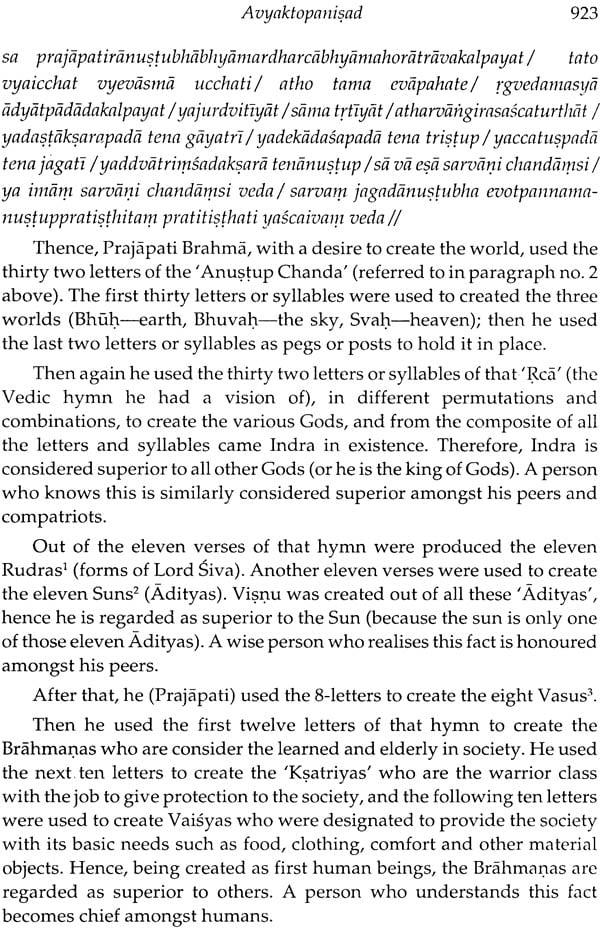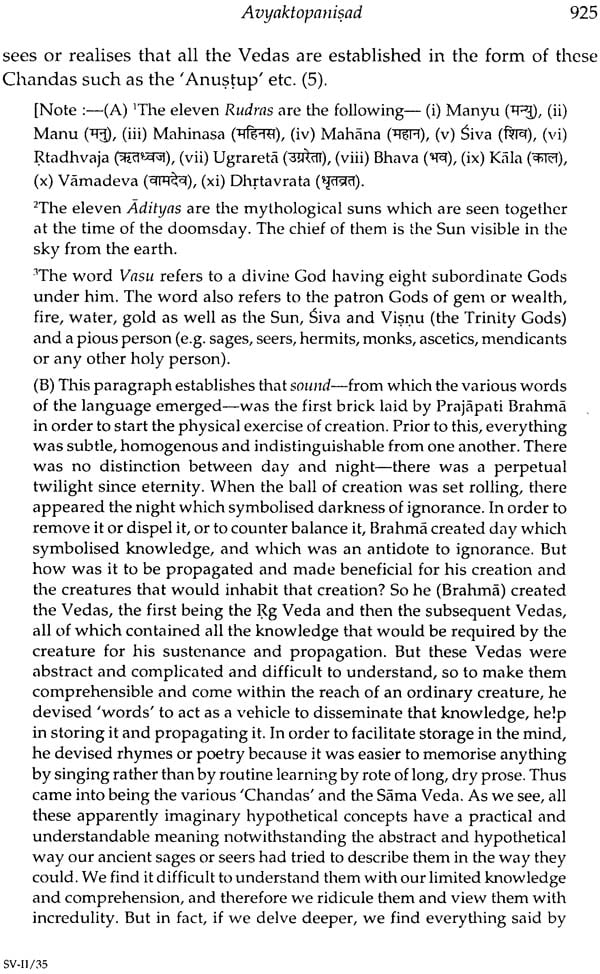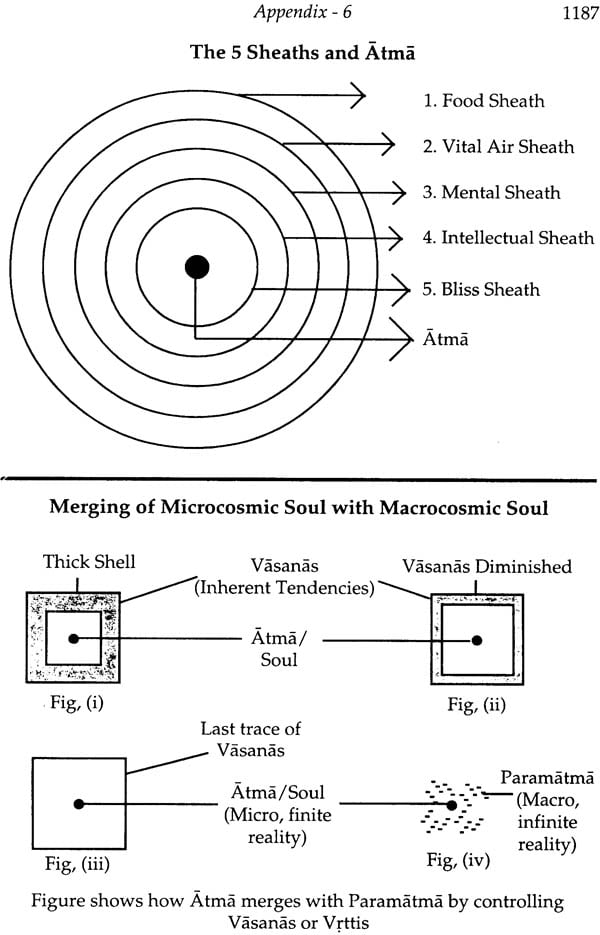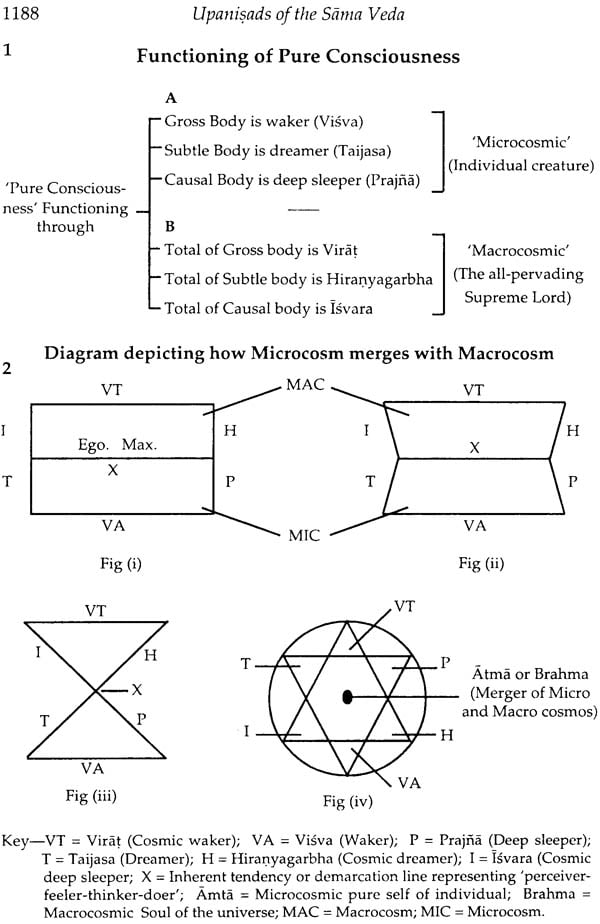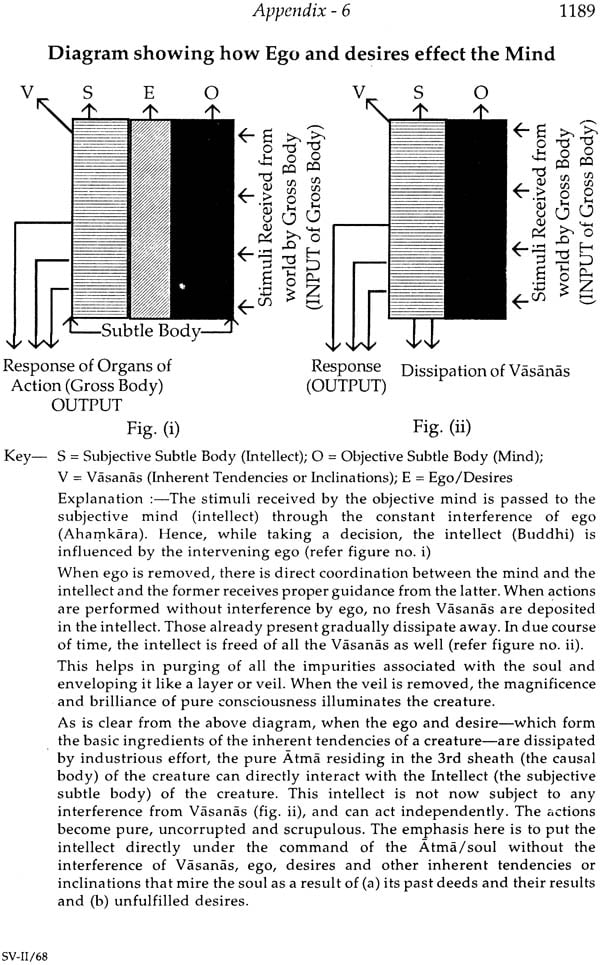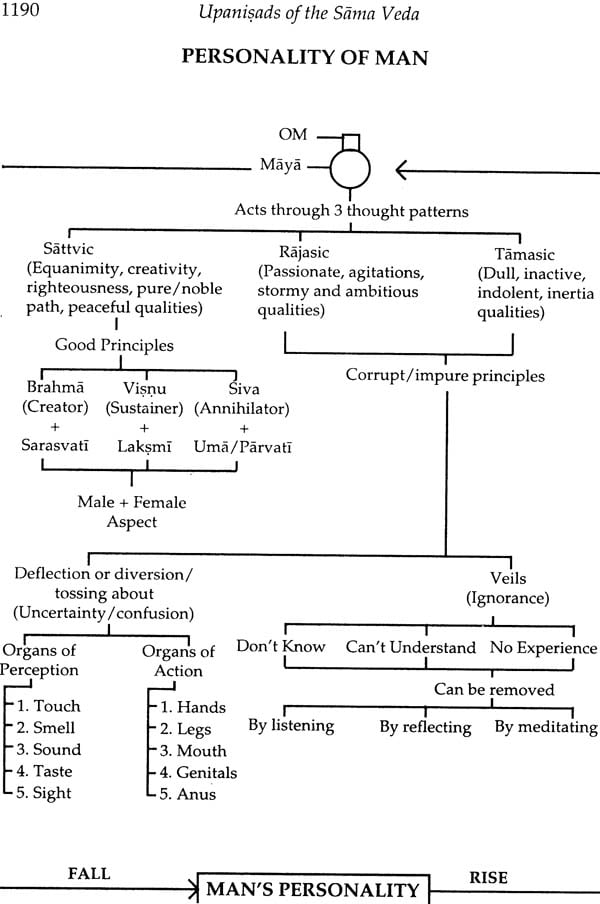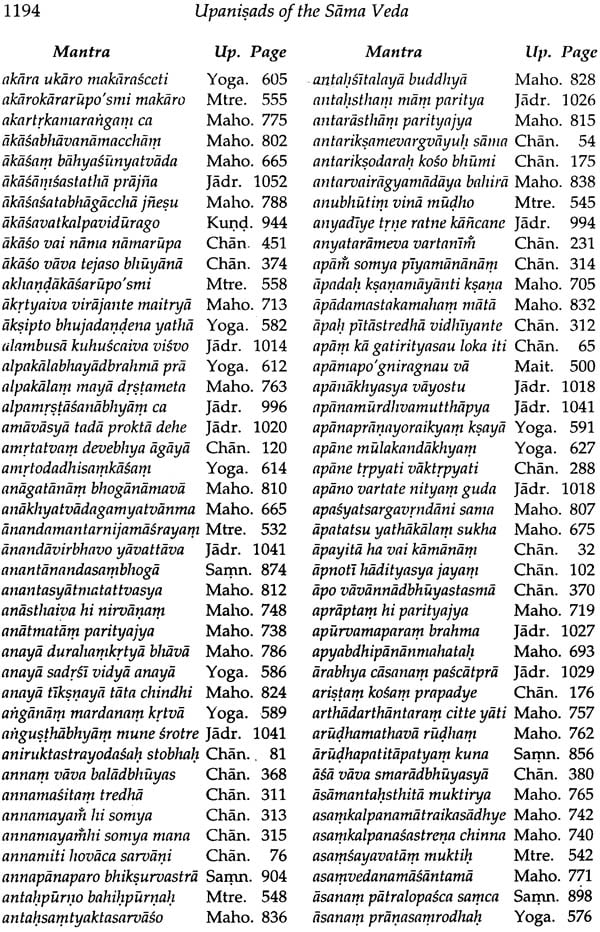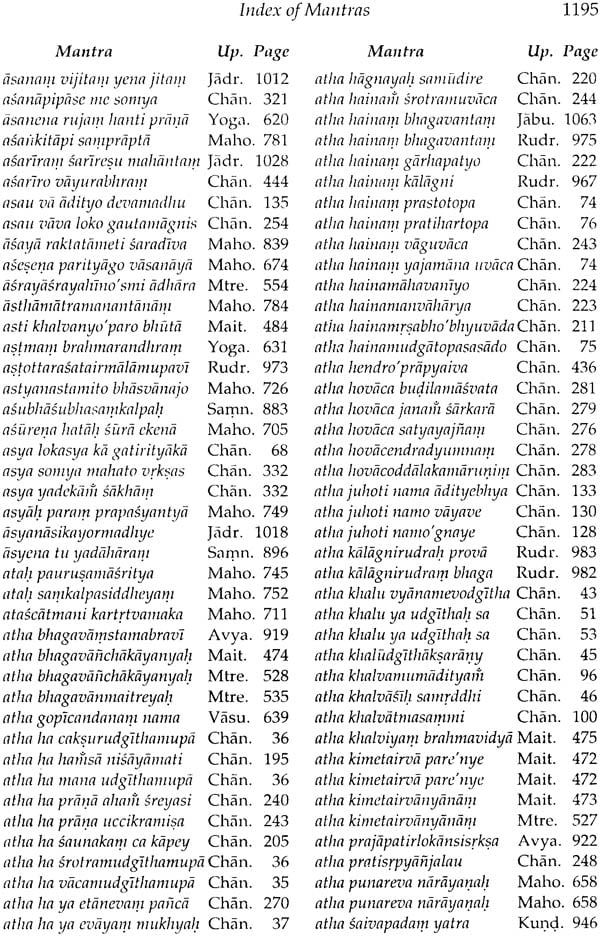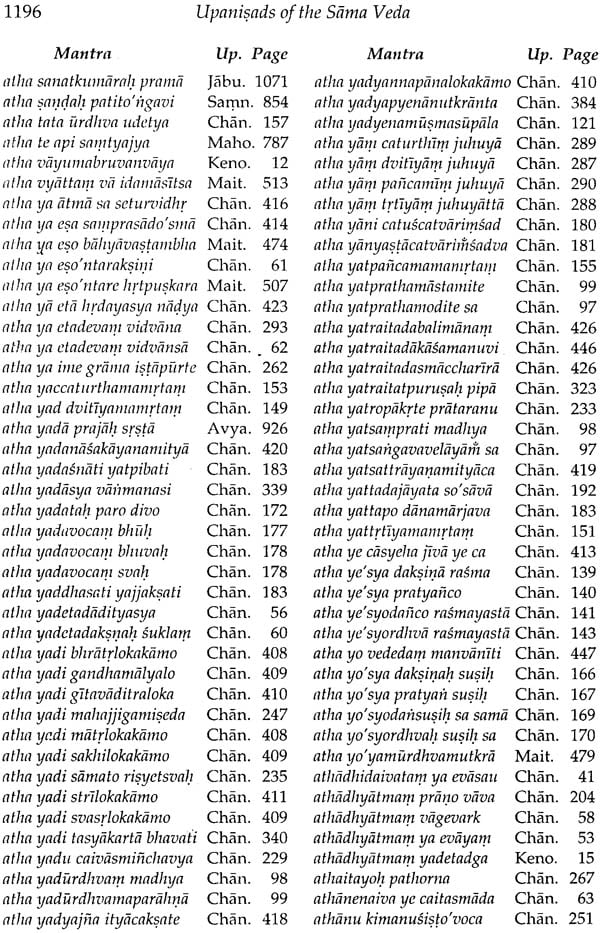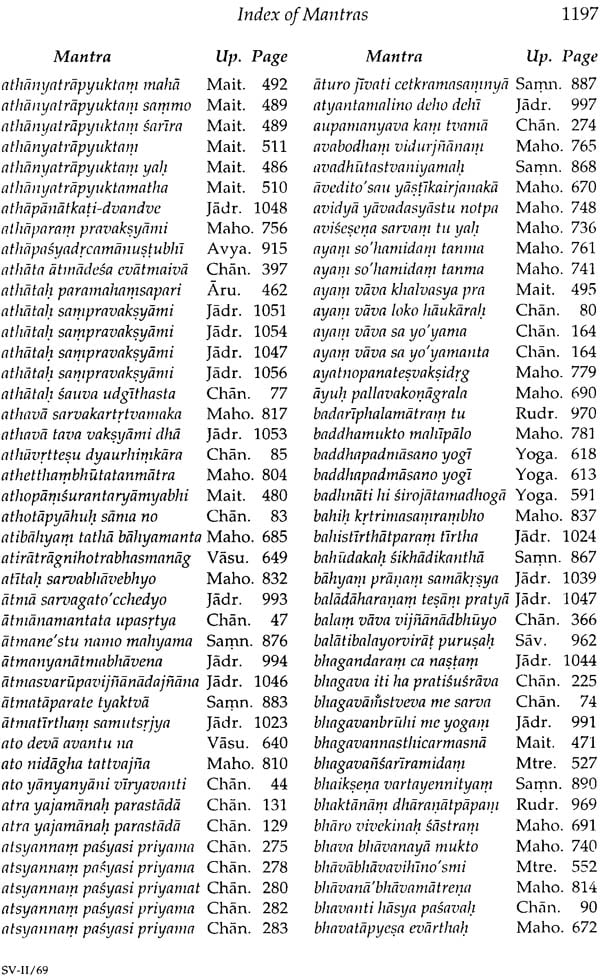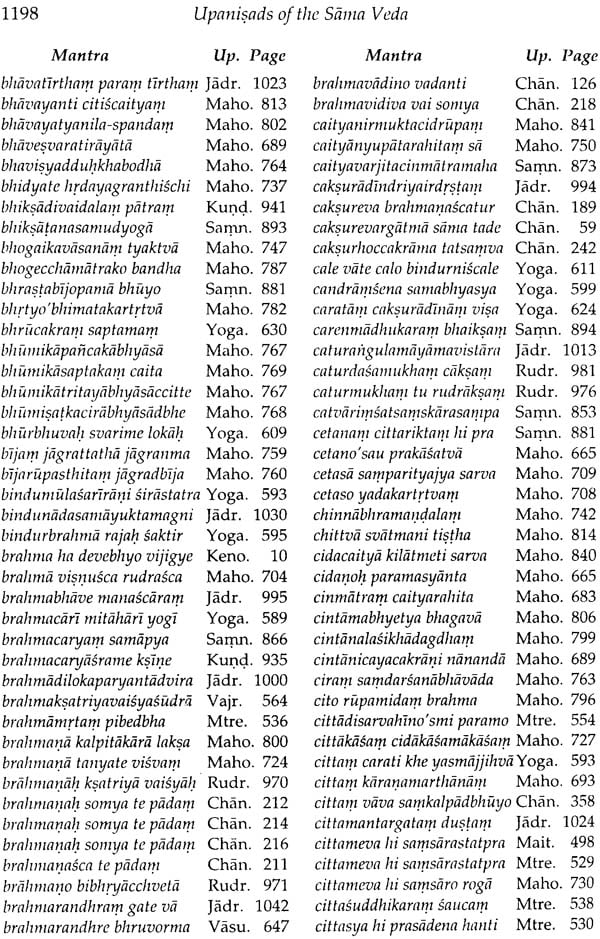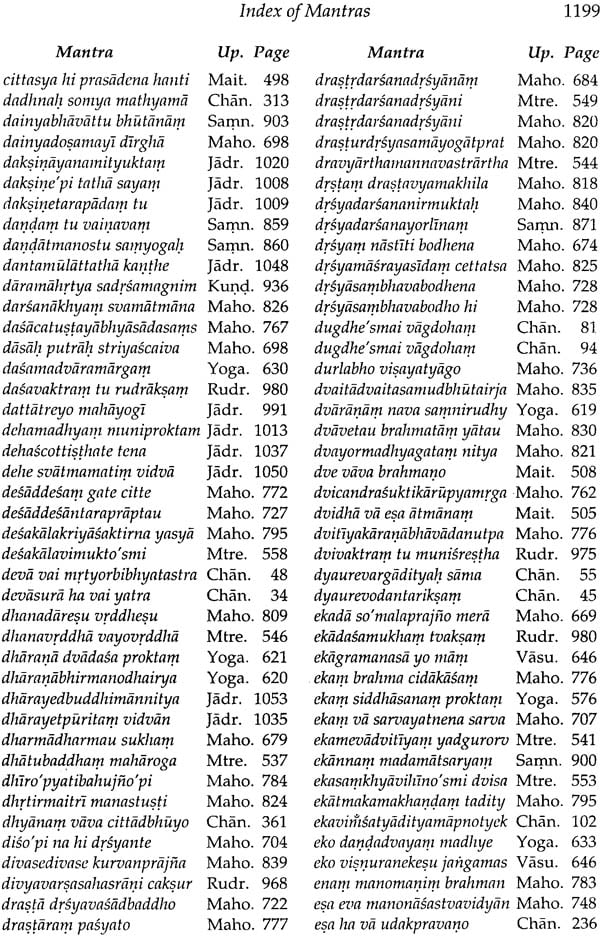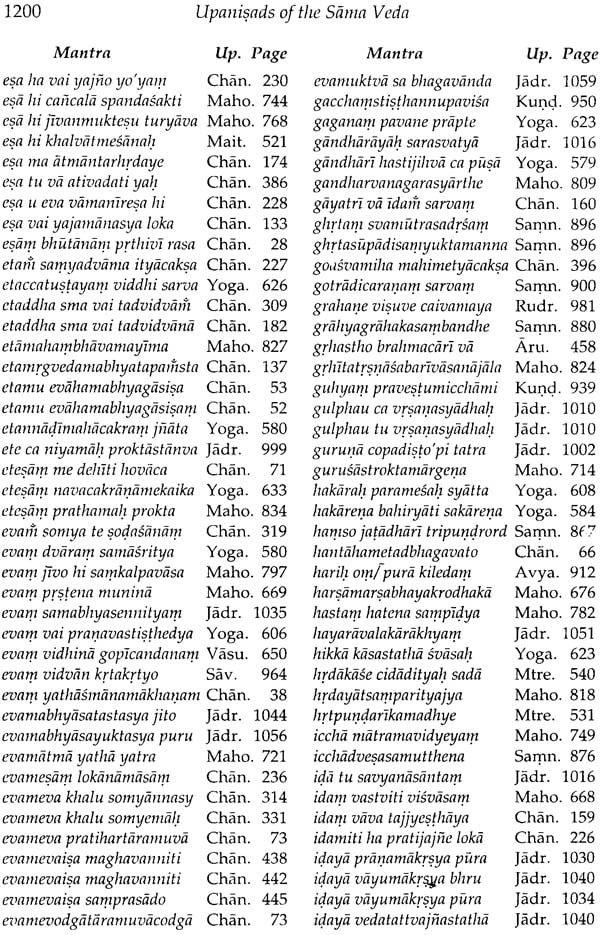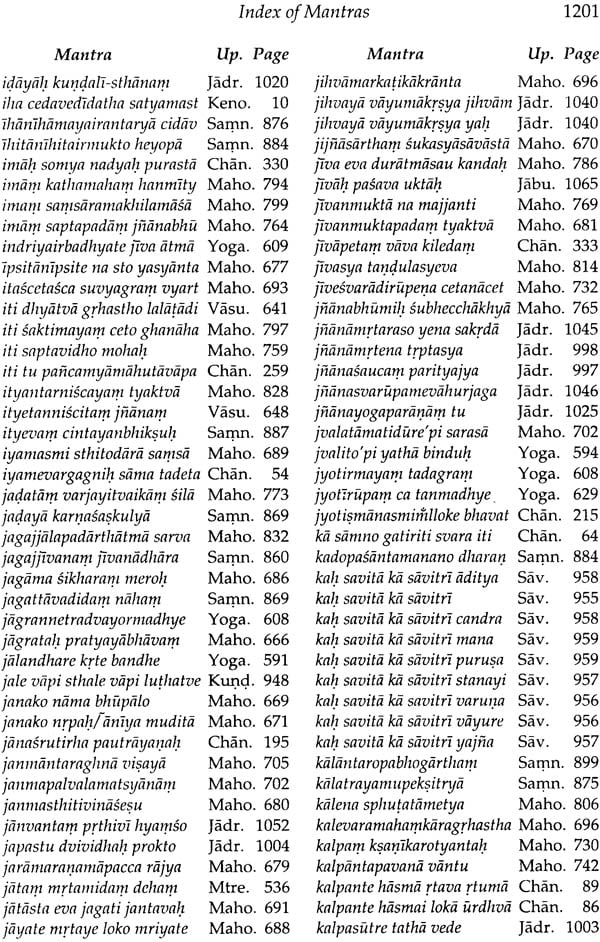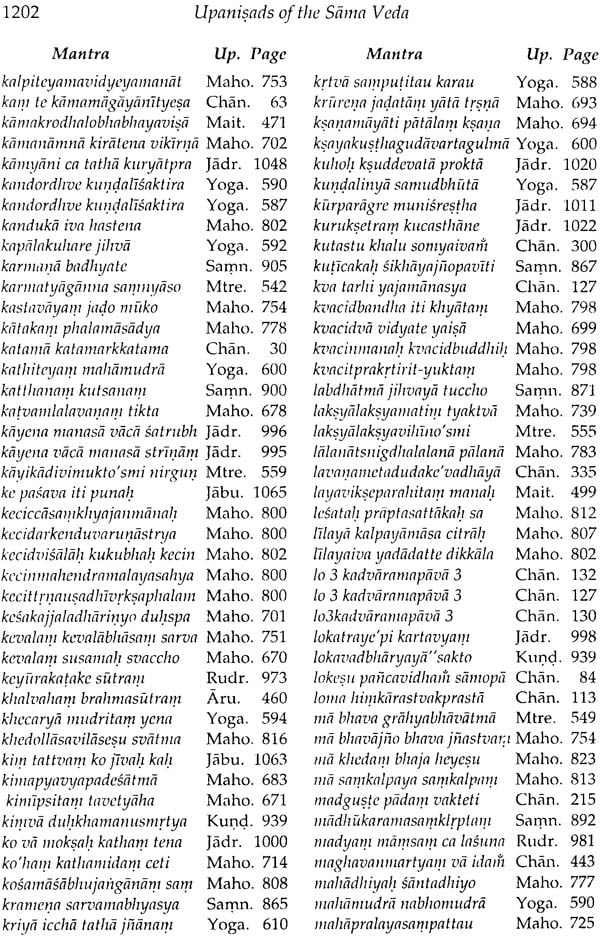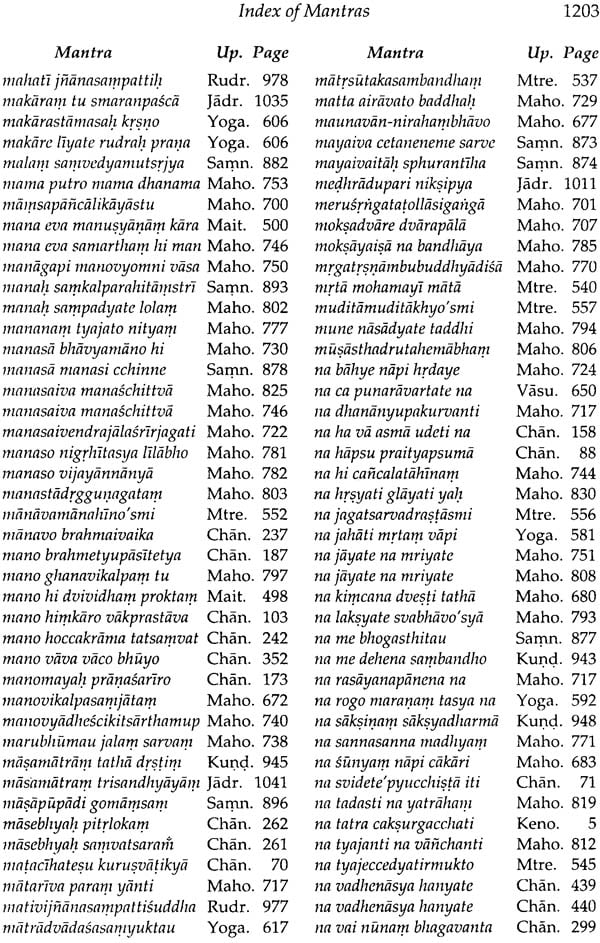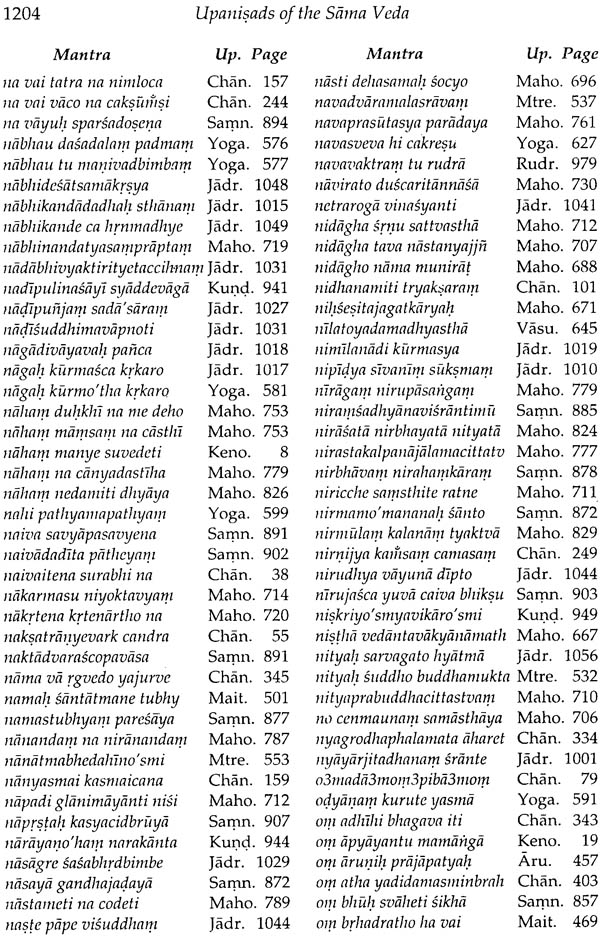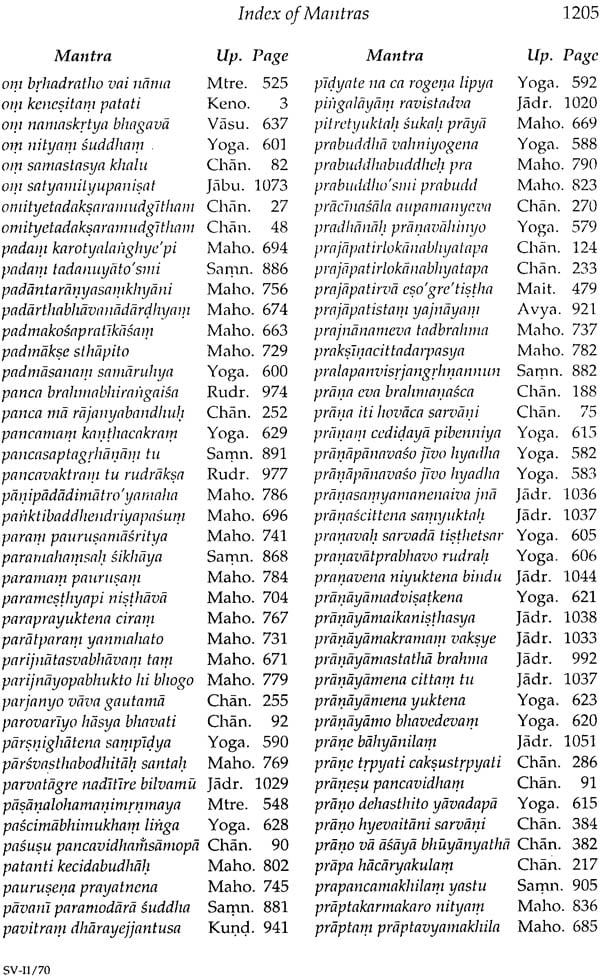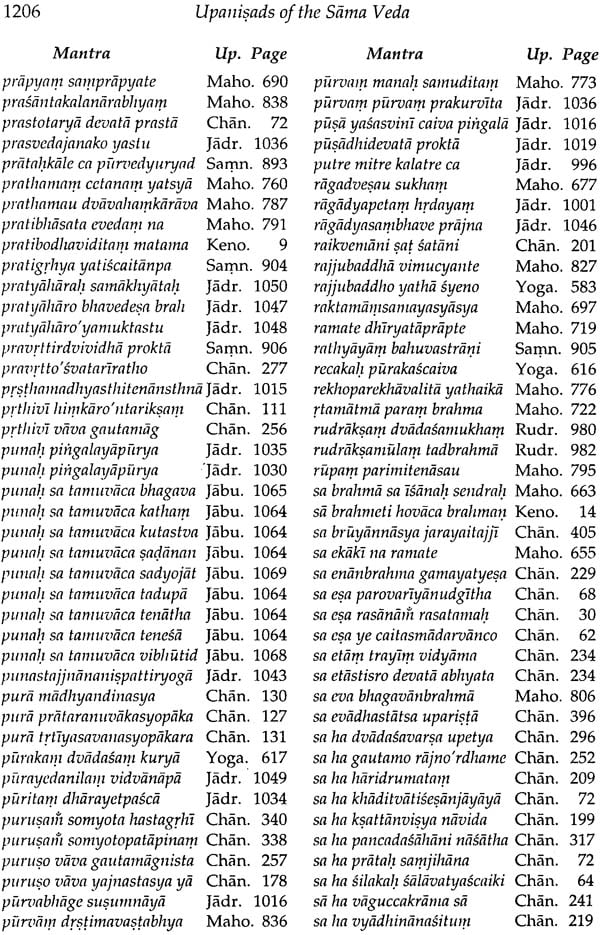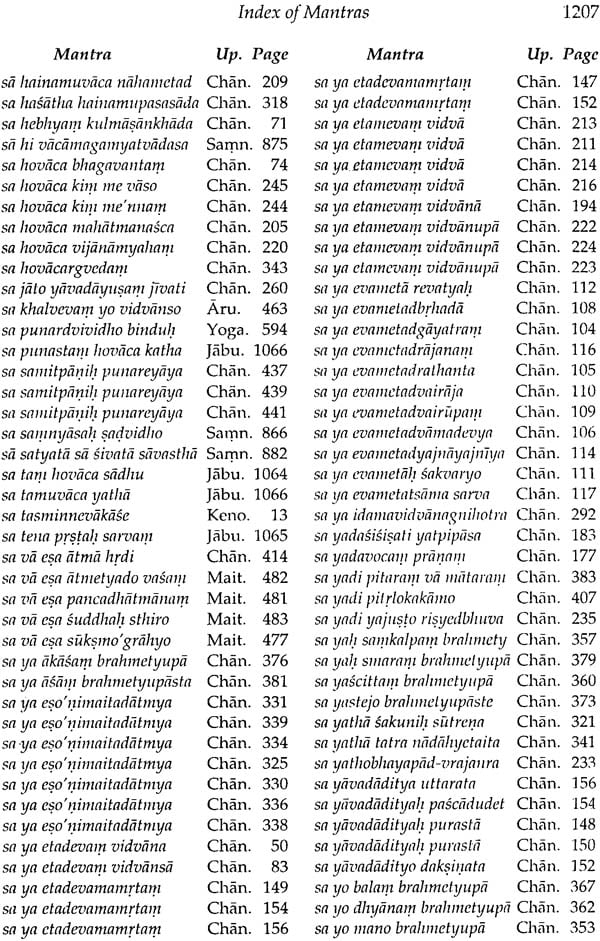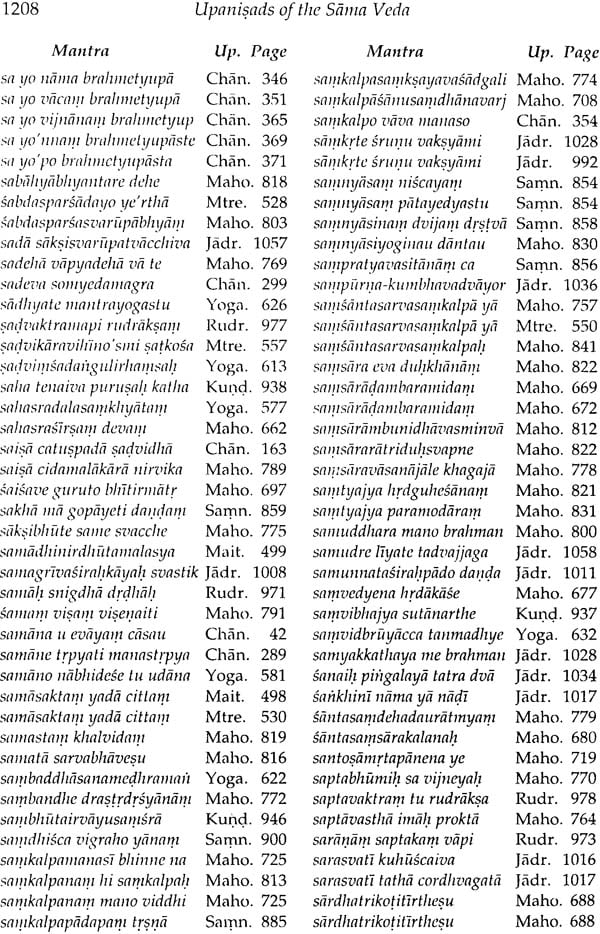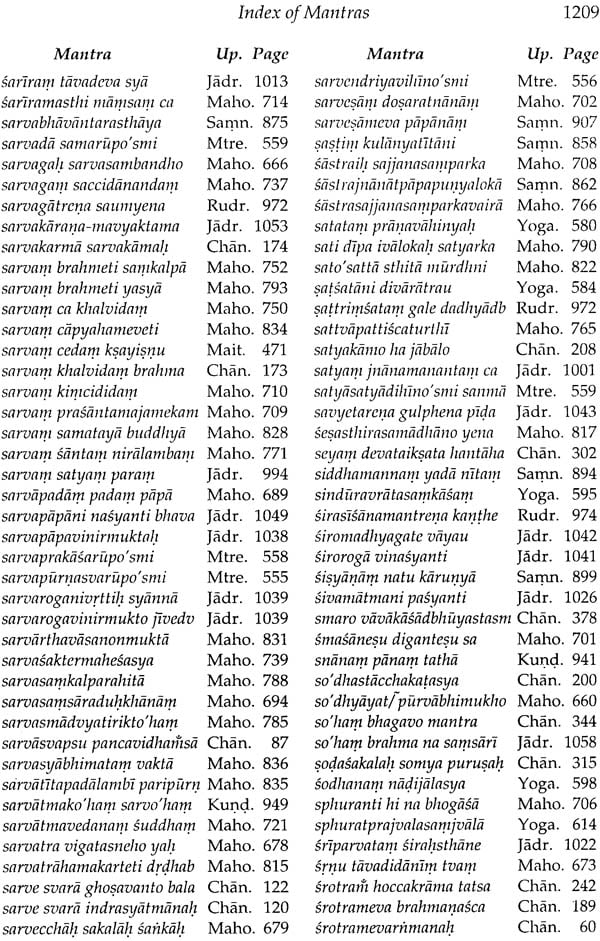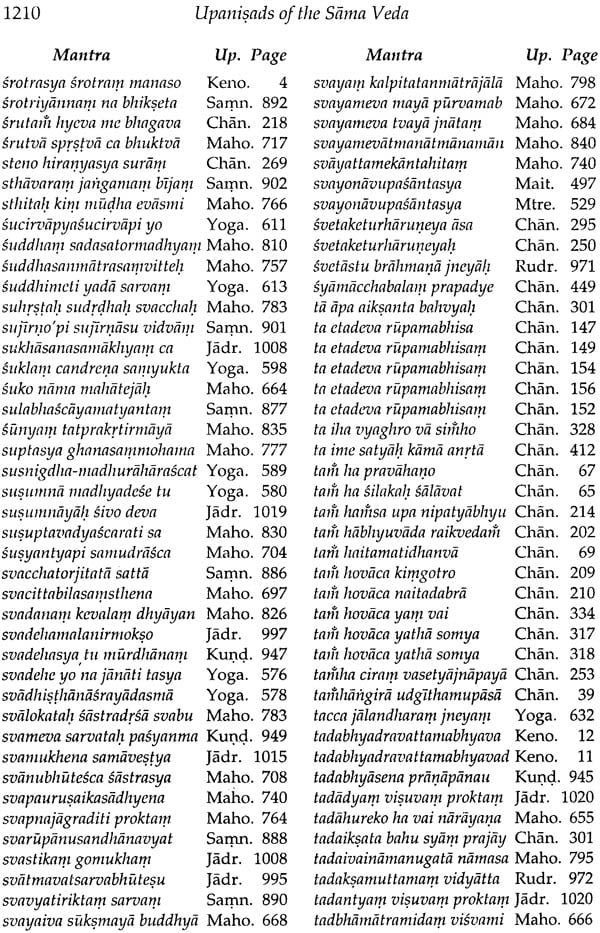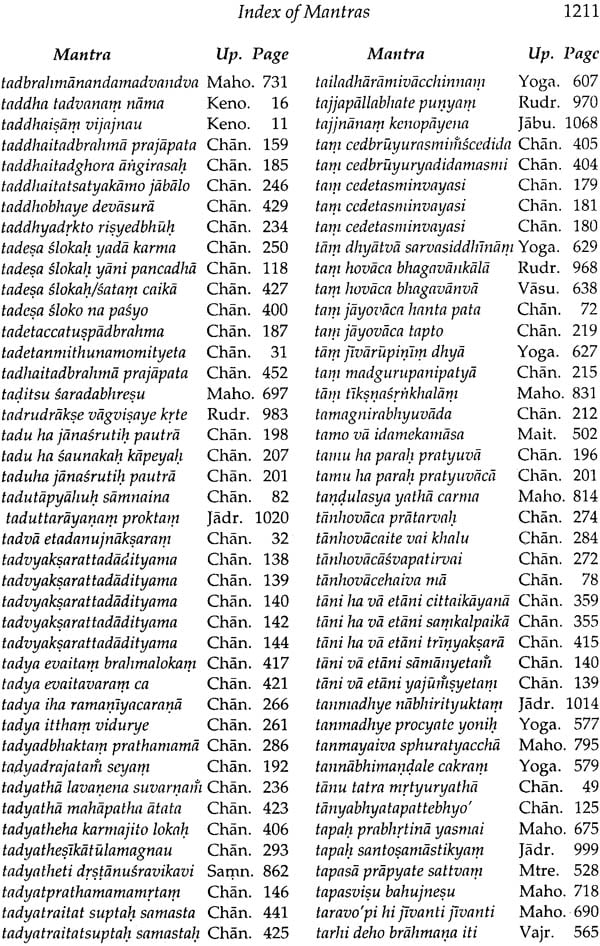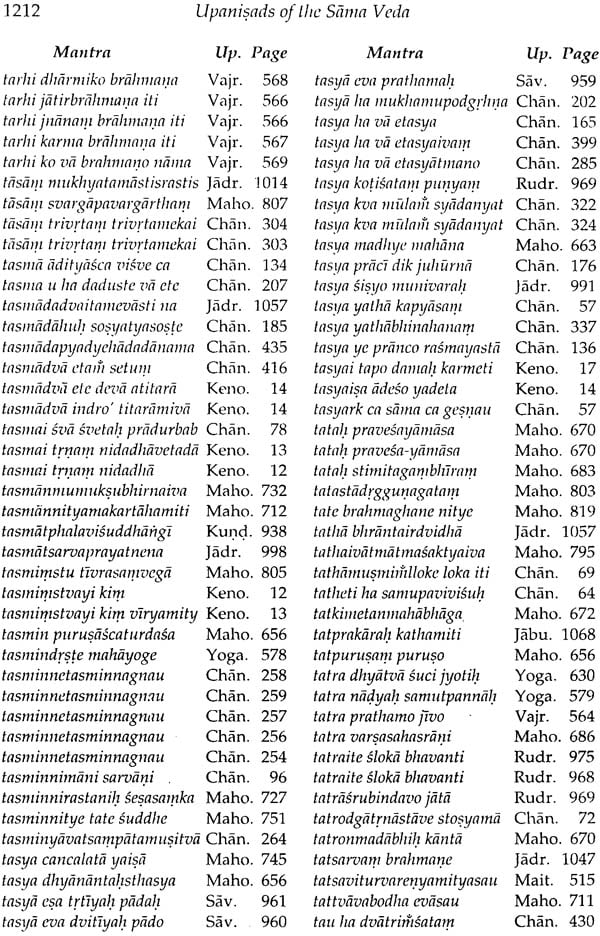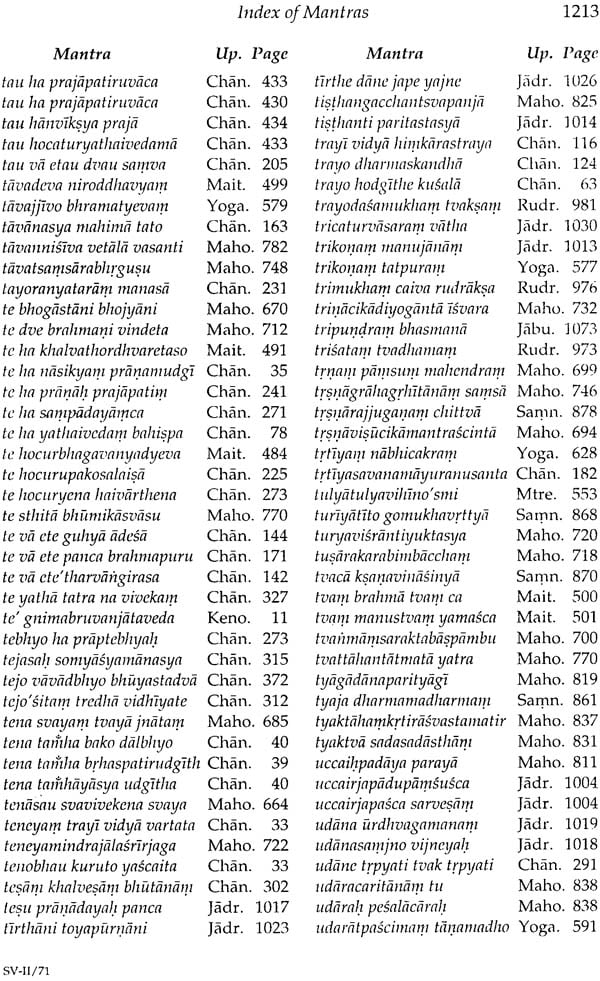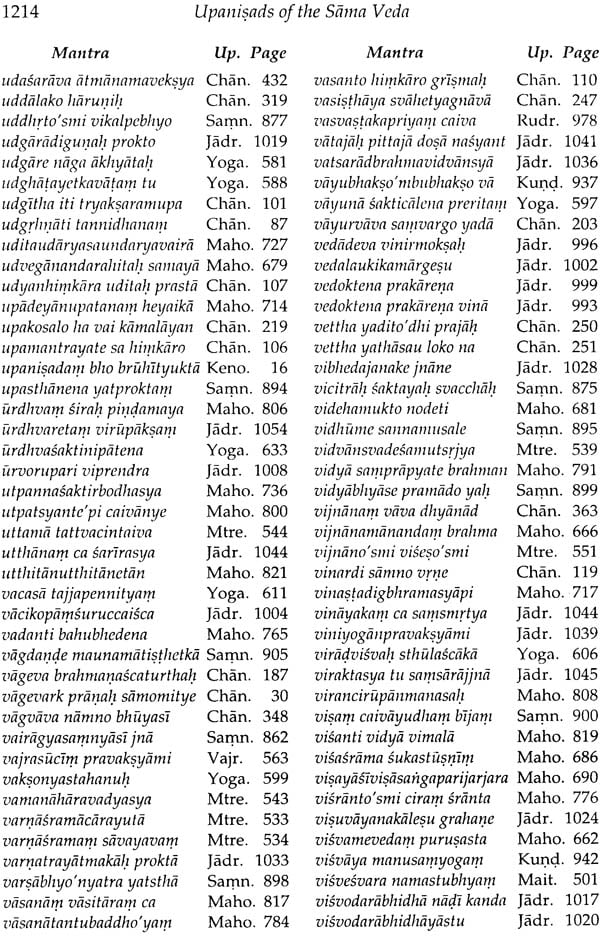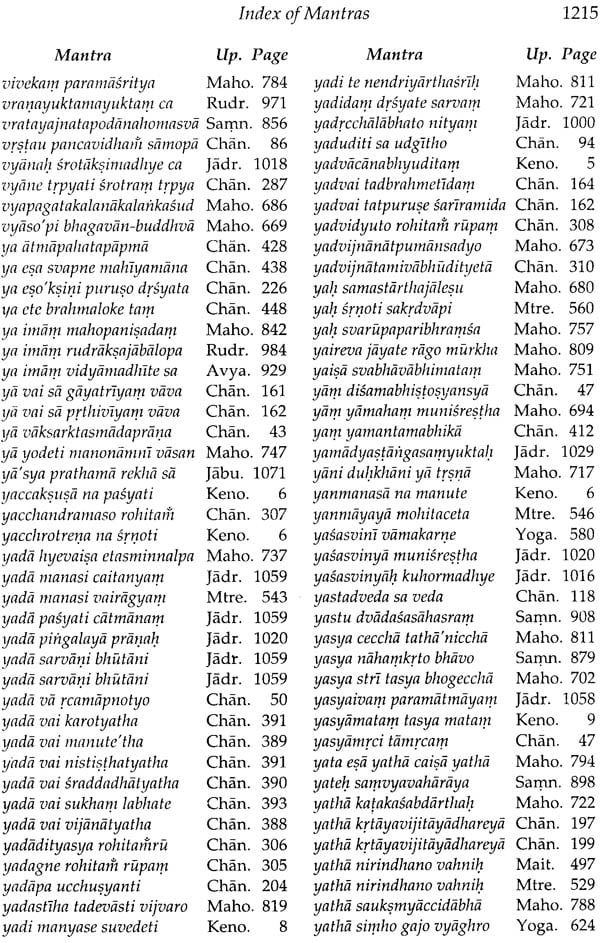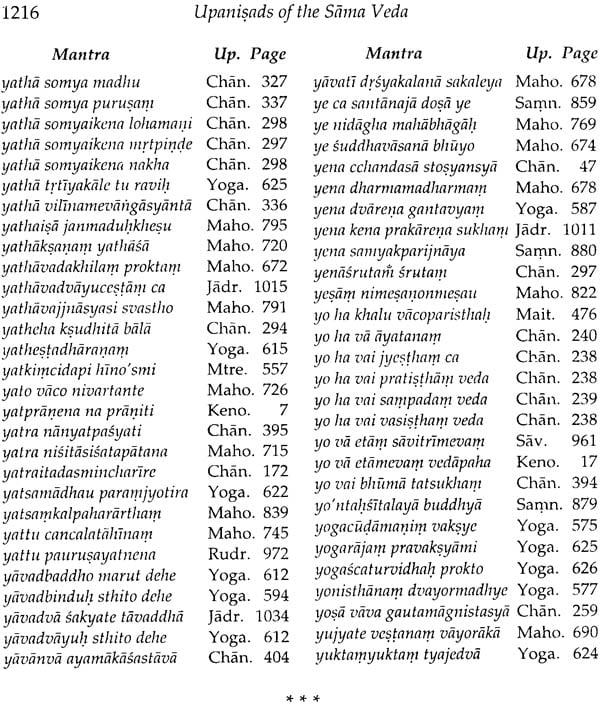
One Hundred Eight Vedic Upanisads (Volume 2: Upanisads of Samaveda) (Bound in Two Parts) ((Sanskrit Text with Transliteration, English Translation and Commentary alongwith Explanatory Notes, Relevant Appendices etc.))
Book Specification
| Item Code: | IHF026 |
| Publisher: | Chaukhamba Surbharati Prakashan |
| Edition: | 2019 |
| ISBN: | 9789380326009 |
| Cover: | HARDCOVER |
| Other Details | 9.4” X 6.4” |
| Weight | 2.28 kg |
Book Description
ISBN:9789380326023 (Part-I)
ISBN:9789380326030 (Part- II)
From the Jacket
The Eternal Upanishads represent the profound essence, the succulent juice and the perennial spiritual philosophy of the Vedas, expounded and elucidated to make them practical and accessible for spiritual aspirants. They are magnificent, stupendous, forceful and powerful instruments in the hands of true seekers that provide spiritual foresight and vision of the ultimate Truth and reality.
The Upanishads are integral part of the Vedas; each Veda has a number of Upanishads in it. The present series classifies these Upanishads in true vedic tradition, i.e. they are listed and separated into different volumes strictly according to the Vedic sequence and the Vedas they appear in.
Each verse of each Upanishad has been extensively explained using simple language supplemented by elaborate notes so that these profound metaphysical treatises can be made accessible to even a lay man. Towards this end, extensive appendices have been added to elucidated the different concepts in simple words. Concepts such as OM, Naad, Naadis, Chakras, Yoga, Atma, Viraat, Moksha etc. are all elaborately explained in these separate appendices, a Mantra index in roman in also included.
The present volume contains 16 principal Upanishads of the Rig Veda. The sequence of their listing in this volume strictly follows the sanction of the Upanishads themselves, as is Clear in Muktikopanishad, cant 1, verse no. 56.
Ajai Kumar Chhawchharia born on 8th August, 1955 in Burdwan district of West Bengal, is a humble and unpretentious bachelor, who has dedicated his entire life to the service of Lord Ram. At present he is residing in the holy pilgrim city of Ayodhya (U.P. India) since 1985.
Preface
‘All come together, you all, with the power of the spirit, to the Lord of the heaven who is but one. He is the revered guest for the people. He, who is most ancient and from the beginning, desires to come to the ‘new’. To him all the pathways lead or turn. Verily, he is One and the Only One’ (Sama Veda, 372).
‘I am the vine, you are the branches. Those who abide in me, and I in them, bear much fruit, because apart from me, you can do nothing’ (Holy Bible, St. John, 15/5).
‘As the different streams having their sources in different places all mingle their water in the sea, sources in different tendencies, various though they appear, crooked or straight, all lead to Thee’ (Svami Vivekananda, World Religion Parliament, 11/9/1893, Chicago, USA), ‘Open your eyes and see him’ (Swami Vivekananda Complete Works, 2/146).
Sama Veda has sixteen Upanisads and their ‘Santi Mantra’ is ‘Apyayantu Mamangani’. These sixteen Upanisads are the following-(1) Kena, (2) Chandogya, (3) Arunika, (4) Maitrayani, (5) Maitreyi, (6) Vajrasucika, (7) Yogacudamani, (8) Vasudeva, (9) Mahat, (10) Samnyasa, (11) Avyakta, (12) Kundika, (13) Savitri, (14) Rudraksa-jabala, (15) Jabala-darsana and (16) Jabali [56].
The above quotation from Muktikopanisad firmly established the list of Upanisads belonging to the Sama Veda tradition. In this Upanisad, Sri Rama has told Hanumana that there are sixteen Upanisads belonging to the Sama Veda. In this anthology, in true Vedic tradition, I have followed exactly the same sequence as prescribed by Sri Rama to Hanumana in listing and narrating those Upanisads, viz. I start this anthology with the Kenopanisad and culminate it with Jabalopanisad. The original Sanskrit texts, their simple layman’s lucid version in easy flowing English, simple explanatory notes to clarify various conceptions as and when they appear in the text, their probable interpretations, along with several appendices etc. will make this bouquet useful while being vibrant, coulourful, attractive, lively, succulent and unique at the same time. Knowledge, especially when it relates to divinity and spirituality, is a pleasant perfume which wafts soothingly over the ruffled terrain of our mundane, arduous existence and lends purpose to it, gives hope in the otherwise hopeless whirlpool represented by this mirage-like world which traps and sucks everything down in its vortex of delusions, and is like the bright and glorious Sun rising in the horizon to lighten up all the directions of the realm of our existence and lift the veil of darkness of ignorance and delusions that has spiritually blinded us.
There are in all sixteen Upanisads in the Sama Veda-each has been included in this book as separate Chapters exending from Chapter 1 to 16, the details of which can be seen in the ‘Contents’. At the beginning of each Chapter, I’ve included a brief introductory paragraph to explain in brief the idea elucidated in that particular Upanisad. Each Chapter has the original Sanskrit text accompanied by simple, easy flowing and lucid English version. As a benediction I’ve included ‘Pranavopanisad’ which at once transports the reader from the humdrum existence of a life full of noise and turmoil to a higher plane of existence where he prepares himself to experience a rarefied and divine atmosphere permeated by the supreme Brahma which is calm, peaceful, blissful and tranquil. It leads the reader on a journey of spiritual discovery, from the temporal to the ethereal. Further, a number of appendices are added to elucidate on various subjects or topics appearing in the main text, though I’ve tried to explain them on the spot briefly wherever they occur in the text. These appendices are the following-appendix 1 explains the meaning of the ‘Santi Patha’ of the Sama Veda Upanisads, appendix 2 deals with the concept of ‘Samnyasa’ and it includes a wide swathe of verses from Bhartrhari’s Vairagya Satakam to add flavour, fragrance, vibrancy and succulence to this concept; appendix 3 deals with ‘Cakra and Nadi’, appendix 4 explains the concept of the cosmic ‘Nada and OM’, the divine word, appendix 5 deals with ‘Mantra, Tantra and Yoga principles, including an elaborate discussion on contemplation and meditation’; appendix 6 explains the various ‘Vedantic Concepts’ in simple and lucid English, appendix 7 lists the ‘Mantras of the Upanisads of the Sama Veda’ in alphabetical sequence, while appendix 8 has the ‘Dedication and a list of other books by this author’.
On the subject of Samnyasa (renunciation and detachment from this materialist world) dealt with in a number of Upanisads, there is an ancient Sanskrit text by ancient India’s enlightened king-turned-sage named Bhartrhari who wrote Vairagya Astakam. It’s a poetic composition encapsulating the teachings of the Upanisads dealing with the subject of renunciation in a very succulent and heart-touching composition. I was so enamoured and compelled by them that I’ve included a wide swathe of those verses in appendix no. 2 dealing with Samnyasa to add a distinctive flavour to this book.
The Upanisads advise mankind to turn away from the illusionary and transient benefits that the world appears to offer and instead aspire for spiritual perfection and elevation. The Upanisads’ main subject matter is the essential nature of the world, the individual self and the supreme Self and their inter-relationships. The seeker begins to see things in a homogenous way in a different perspective which is rational, empirical and well thought of.
‘The Vedas, in the form of divine and cosmic words or sounds, have their abode in the vast space of the sky where all the Gods reside. What can a man get or benefit by reading or reciting the Vedas if he does not make an effort to understand that supreme knowledge (called Brahma, a knowledge which is eternal, absolute, universal and truthful)? That person who realizes the truth about the vast sky (or the essential tenets) of the vast repository of knowledge embodied in and personified by the Vedas), verily, he finds permanent abode in it i.e. he becomes so engrossed in that knowledge that he literally drowns or submerges himself in it. And since this knowledge is as vast as the sky, the seeker/aspirant is deemed to have taken residence in the sky of the knowledge represented by the Vedas. In other words, he dissolves himself and loses his independent identity as a creature and becomes one with the transcendental knowledge (of Brahma) as contained in the Vedas, and consequentially, finds permanent peace, bliss and beatitude there. This is verily what this Upanisad says’ (9).
The Upanisads are forceful, powerful, stupendous, magnificent and eloquent statements made in response to pointed questions by the disciples (seekers/aspirants) who were themselves Rishis of repute. They emphasise the knowing of the ‘truth’, investigating and discussing it, constantly contemplating upon it and putting them into practice to redefine oneself. They have wide ramifications and transcend all religious and cultural boundaries. The Upanisads are divine words which reflect the glory of the intellect and the depth and width of the knowledge of India’s ancient sages and seers. They can be read, thought over, taught and re-written in the form of translations in different language (while still retaining their originality). They are not lifeless alphabets as such. They are synonymous with the supreme light of knowledge that dispels darkness of ignorance and is symbolic of life. Since the vehicle for transmission of the profound truths are words, the Upanisads emphasis, like the Bible and the Guru Granth Sahib (the scripture of the Sikh religion) that the ‘word’ is the truth, the reality, the equivalent of the Lord, the God, the Brahma, the cosmic ‘Nada’ (sound), OM, the very essence of life. The Bible explicitly says-‘(a) In the beginning was the word, and the word was with God, and the word was God (gospel of St. John, 1/1), (b) And the word became flesh and dwelth among us-full of grace and truth (John, 1/14)’. How stupendous, how magnificent, how profound, how succinct, how lively are these words indeed! Therefore, the Upanisads are not lifeless books but ‘the body’ of knowledge, ‘the abode’ of knowledge. The quest for truth is the spark that injects vitality and vibrancy to a bunch of alphabets which lead the path to enlightenment.
The Upanisads represent the highest citadel of philosophical evolvement of human kind. The canons of the Upanisads are essentially teachings of ancient savants, seers and sages who were erudite and sagacious, genius and enlightened, had scholarly acumen. They had enunciated the principles of the Ultimate Truth and Reality about this existence and the forces governing it both in philosophical as well as in metaphysical terms. These treatises were not merely hypothetical but empirical as well; they were the result of deep investigative minds which delved deep into the reaches of the unknown and after thorough exploration, investigation, examination, experimentation and application, they arrived at irrefutable, incontrovertible conclusions. They were pioneers in this field is as much as they delved into hitherto unknown realm of metaphysics and, therefore, can be called the forefathers of constructive and logical thinking as well as spiritual scientists.
They learned spiritual disciplines, proposed and tested hypothesis, applied variables, corrected any errors they discovered in their hypothesis, retraced their steps and moved ahead with the new path which stood the test of methodical, scientific and empirical experimentations. When a successful method evolved, they preached it to their disciples in the words of the Upanisads. These doctrines enshrined in these texts are therefore a result of extensive and industrious labour, insight and research. These doctrines are practical and modern day. Exponents of Upanisadic philosophy have indeed tried to explain their precepts in scientific way. The readings of these texts have had a profound psychological impact on generations after generations. They have tried to present a remedy to a world overwhelmed by misery and tumult.
Furthermore, the brightest point in Upanisadic teaching is the fact that a follower of any religious dispensation can benefit from them-they aren’t a set of meaningless rituals and dogmas but proven metaphysical truths that can benefit an afflicted mind-body of an individual because they help him to realize the futility of worldly pursuits, of craving for the world and its material objects which are indeed all perishable in the end. The alternative it prescribes in uplifting for the individual. These doctrines do not come in the way of his day to day work of life but only makes the life better for him to live. To quote Svami Vivekananda-‘Whenever you hear that a certain passage of the Vedas come from a certain Rsi (sages/seers), never think that he wrote it or created it out of his mind; he was the ‘seer’ of the thought which already existed; it existed in the universe eternally. This sage was only the discoverer’ (Complete Works, 3 (1970)/119)
These sages/seers concluded, inter alia, that the physical world perceived through the sensory organs was not the real world; it did not provide peace and happiness to the creature. Since everyone wants peace, tranquility, bliss and happiness, there must be something other than this physical world that was the ‘truth’. This, they realized was the Brahma (or Brahman). Where is Brahma seated? Brahma is hidden in the heart and it is known by the pointed and subtle intellect’ (Kathopanisad, 1/3/12) and ‘The immortal Brahma alone is before and behind, to the right and left, above and below. This world is verily the supreme Brahma’s (Mundaka Upanisad, 2/2/12).
The creature, they concluded was not the physical, decayable, tormented body, but the pure, indestructible Atma (soul). This Atma (soul) is pure consciousness, eternal, peaceful, happy and blissful. This awareness was self-realisation. How is it obtained? ‘Self is attained by practice of truth, austerity, right knowledge and continence, self control and abstinence’ (Mundaka Upanisad, 3/1/5). The laboratory was their mind-intellect apparatus; the chemical for the various tests was their power of intellectual discrimination, and penetrating insight was their microscope. The fact that they obtained peace, tranquility, happiness and bliss as well as contentedness proved the fact that their theory was indeed correct, that it was indeed the ultimate Reality which mankind sought for. Their dedicated and focused understanding, outstanding research, analytical thinking, surgical precision and superb examples to illustrate their observances resulted in the pronouncement of doctrines having wide ramification and tremendous import. They disbursed this vast ocean of knowledge for the benefit of this disciples (i.e. seekers/aspirants/students), and through them, to the humanity as a whole. These doctrines, which are absolute Truths or irrefutable axioms, have been condensed for posterity in the form of Upanisads. These most venerated books are expositions of superb minds with matured thinking, striking in their clarity of thought and expression, are precise and clinical, have a strong fundamental basis that can be experimented by serious seekers as to their veracity and practicability, and have had a tremendous impact on western scholars who chose to study them.
To explain the relationship between Braham, Atma and body in a simple way, the allegory of the chariot is taken. The body is the chariot, the soul is the true owner, the horses are the sense organs, mind is the bridle, intellect is the charioteer, the 2 wheels are the physical and spiritual life, and their movement means progress in both fronts. This allusion is sufficient to explain the whole setup. ‘The chariots of God are twenty thousands, even thousands of thousands’ (Psalm, 68/17), where the individual chariot is the creature.
The Upanisads are like concentrated beams of laser rays-they are focused, powerful, potent, specific and surgical in their approach. And since the final and ultimate truth has to be one-which is Brahma-all the Upanisads’ final goal is also Brahma. All tell us that the ultimate knowledge is the realisation of Brahma, and what is the characteristic feature of this entity called Brahma? It is eternal, attributeless, absolute, non-dual, all-pervading, all-encompassing, omniscient, omnipotent, pure and supreme consciousness which is the macrocosmic soul of Nature as well as the microcosmic soul/Atma of the creature. To make the seeker/aspirant aware of Brahma, about its true nature and essence, about the fact the Atma is indistinguishable from Brahma, is the basic aim and object of the Upanisads. They seek to define Brahma in all possible ways.
The benefit derived from the study of the Upanisad is that the creature realizes his true and essential from and nature. He comes to comprehend the essence of the vast cosmos of which he is a part. The resultant awareness fills him with bliss and happiness, contentedness and satisfaction. The Upanisad emphasizes the importance of acquisition of truthful knowledge of the attributeless and infinite, but attainable and absolute Reality and Truth which it calls Brahma. The knowledge of Brahma leaves nothing more to be learnt. ‘Therefore, whosoever heareth these sayings of mine, and doeth (i.e. trusts them implements them), I will take him unto a wise man which (who) built his home upon a rock’ (Bible, gospel of St. Matthew, 7/24). Then, such a person becomes’ ye are the light of the world’ (Bible, St. Matthew, 5/14), obtains eternal life and bliss-‘I give unto them eternal life, and they shall never perish’ (Bible, gospel of St. John, 10/28), finds salvation-The Lord redeemeth the soul of his servants’ (psalms, 34/22), and such a person becomes one with the Lord-‘believe me that I am in the father and the father in me’ (Bible, gospel of St. John, 14/11). This is the final aim of the Upanisads-to ignite or kindle the process of self-realisation in the seeker/aspirant and lead him to the ultimate Truth and Reality.
The knowledge of the Upanisads frees the creature the fetters shackling it to this world and provides it with deliverance and liberation even as a bird finds freedom from a cage and flies off into the vast sky. This liberation provides immense joy and exhilaration to the creature because it finds itself liberated much like the caged bird.
Remaining oblivious of the teachings of the Upanisad would be spiritual deprivation of the worst kind for a person walking on the path of spiritual upliftment and enlightenment. The Upanisads are a complete compendium for an enlightened way of life.
The Upanisads abound in beautiful imagery, allegory and similies. The imagery is intented to make the concepts simpler to understand and more endearing. For example, (i) The Katha Upanisad has an allegory of the chariot-the body is the chariot and the individual is the master (Katha Upanisad, 1/3/3/4), (ii) The Mundaka Upanisad gives the example of 2 birds eating from the same tree-one bird is the soul of the creature while the other is the supreme Soul of the cosmos (Mundaka Upanisad, 3/1/1-2). (iii) Similarly, creation has been vividly described’ as a spider spreading out and withdrawing its thread, herbs growing and perishing on earth and hair on the human skin’ in Mundaka Upanisad (1/1/7). (iv) With the example of the ‘bow’ as the medium of the knowledge contained in the Upanisads, the soul as the ‘arrow’, and the Brahma as the ‘target’, The Mundaka Upanisad 2/2/2-5 stresses the need to focus on Brahma with this magnificent allegory of an archer. (v) The Chandogya uses the allegory of the seed of the tree, the salt in the water, the clod of earth, the shadow in the water, the God-demon war, the fire sacrifice itself etc. to highlight the truth about the Atma and the Brahma. (vi) The Kausitaki Brahmana Upanisad uses the example of a wheel (hub-spoke) to describe the relationship between the Atma and the outside world (3/9). (vii) Honey or Madhu has been used as a metaphor for the best and the excellent virtues, and it has been used to expound on great metaphysical truths (Brhad-Aranyaka Upanisad, 2/5/1-19). This is called ‘Madhu Vidya’. (viii) Similarly, the Sun is used as a metaphor along with honey in Chandogya Upanisad, canto 3 to elucidate the profoundest principles of metaphysics. These 2 Vidyas (Madhu and Aditya) are contemplative techniques used in meditation. (ix) The various elementary forces of Nature-The Sun, the Moon, Air, Fire, Water, Earth Directions etc.-all have been used as metaphors to explain Upanisadic maxim and tenets in Chandogya, canto 2 and 5. Stunning logic is used to explain complicated and profound metaphysical concepts in a step-by-step method in the Upanisads.
How misinterpretation of any preaching or tenet, or even a misconception about the ‘truth’, can have catastrophic consequences is very beautifully brought (forth in the episode relating to Indra, the king of Gods, and Virocana, the king of demons, in canto 8 of Chandogya Upanisad. Similarly we see that knowledge was not the exclusive realm of Brahmanas, as many kings were wiser than them as is evident in Kausitaki Brahmana Upanisad where we come across one king Ajatasatru and in Maitreyi Upanisad where we have king Brhadratha. Then we have king Janaka in whose fire sacrifice sage Yajnavalkya had enunciated great metaphysical truths in Brhad Aranyaka Upanisad. Even humble and ordinary birds such as a pelican and a swan had taught sages in Chandogya Upanisad. Not only this, this Upanisad tells us about a humble cart man called Raikva who was wiser than the pious and enlightened king of the realm.
(Svetasvatara Upanisad, 4/1)
‘In the Upanisad, it (the Brahma) is one, attributeless and indescribable. When the same Brahma extends itself many-fold and in myriad of ways into hundreds and thousands of forms and shapes having innumerable contours, virtues and characteristics, the details of all this as a narration of history (or events that have taken place) and their various consequences are made in the Puranas’ (Svetasvatara Upanisad 4/1)
Svami Vivekananda says, ‘The theme of Vedanta is to see the Lord in everything, to see things in their real nature, not as they appear to be (Complete Works, 2 (1968)/312). Vedanta says that you are pure and perfect, and that there is a state beyond good or evil and that is your own true nature. It is higher than Good. We have no theory of evil…we call it ‘ignorance’ (Complete Works, 5 (1970)/282.’
A reader of Upanisads is expected to have broader perspective of what consists of religion, metaphysics, theology and philosophy. He is expected to rise above sectarian narrow-mindedness and see the ‘beauty of the truth spoken in whatever tongue’. In this context about the ‘oneness, singularity and uniformity of the universal truth’ the Holy Quran has this to say-(i) la ilah illallah (there is no other God but one God), (ii) qul huwa llahu ahad (say, the Lord is one), (iii) wa ilahukum ilahum wahid (and your God is one God), (iv) allahu la ilaha illa huwa (God, there is on other God but He), and (vi) wa ma min ilahim illa illahun wahid (and there is no God but one God).
The purpose and importance of truthful knowledge about the ‘Reality and Essence’ of everything, which the Upanisads strive to enumerate ad expose in detail, is also succinctly proclaimed by the Bible:-(i) Fools die for want of wisdom (Proverb, 19/2), (ii) They know not, neither will they understand, they walk on in darkness (Psalm, 82/5), (iii) They will be blind leaders of the blind, and if the blind lead the blind, both shall fall in the ditch (Gospel of St. Matthew, 15/14), (iv) (Therefore), understanding is a wellspring of life (Proverb, 15/14), (vi) By knowledge shall the chambers be filled with all precious and pleasant riches (Proverb, 24/4), (vii) Your testimonies are also my delight, and my counselors (Psalm, 119/24), (viii) Through your precepts I get understanding (Psalm, 119/104).
The fruit of knowledge is:-(i) For the fruit of the spirit is in all goodness and righteousness and truth (Ephesians, 5/9), (ii) Acquaint now thyself with Him and be at peace (Job 20/21). [Really indeed! This last quotation is the real fruit of self-realisation and is affirmed emphatically by the Upanisads.] The Bible further says:-(i) The Lord is my light and my salvation (Psalm, 27/1), (ii) God is light and in him there is no darkness at all (St. John, 1/1/5), (iii) The Lord is a God of knowledge and by Him actions are weighed (1 Samuel, 2/3), and where is this God? The Bible says, (iv) The Kingdom of God is within you (Gospel of St. Luke, 17/21), (v) In him we live and move and have our being (Acts, 17/28).
Regarding this ‘truth’ factor, the Bible says-(i) I am the way, the truth, and the life (Gospel of St. John 14/6). (ii) Send out thy light and thy truth. Let them lead me (Psalam 43/3), (iii) Thy word is the truth (Gospel of St. John 17/17). (iv) The truth is great unto the clouds (Psalms, 57/10), (v) That was the true light which lighteth every man that cometh into the world (Gospel of St. John, 1/9), (vi) Teach me your way, O Lord, I will walk in your truth (Psalm, 86/11). Understanding the truth is the wellspring of life unto him that hath it; he Lord giveth wisdom. Out of his mouth cometh knowledge and understanding (Proverb, 2/6). Send out thy light and thy truth and let them lead me (Proverb, 43/3). Thy word is Truth (St. John, 17/17).
The Upanisads, as we have seen, are based on sound, logical, rational, experienced and empirical thoughts and debates. They present not any religious dogmas but verifiable, empirical truths. Though the language may seem outdated in the present context of the modern world, but gold nevertheless remains gold no matter what dialect is used to name it. They present a body of standard, time-tested knowledge, a knowledge that is in the verifiable realm, empirical experience and rational thoughts. The so many Upanisadic texts are not meant to confound the reader or the seeker in any way, but they only highlight and pluralistic approach of ancient sages to reach a single point called Brahma at the cosmological level (macro level) and the Atma at the temporal level (macro level).
Meaning :- The word ‘Upanisad’ is composed of three Sanskrit Syllables-‘up’, ‘ni’ and ‘shad’. (a) The word ‘up’ means ‘come near, sit down, benevolent, worship, destroy, cure/remedy, disease/fault free, enjoy, without hindrance’. (b) The word ‘ni’ means ‘not, night, darkness, ignorance, special as well as complete/full’. (c) The word ‘shad’ means ‘6 schools of thought, knowledge, to teach, to learn, to calm down, to destroy’.
Hence, the composite word Upanisad means :-(i) to come and sit down quietly before the teacher, (ii) to sit quietly after having acquired truthful knowledge about the reality, having calmed down all agitations and having dispelled all confusions and doubts, (iii) to remove the darkness of ignorance by the light of knowledge, (iv) the endeavour that removes/dispels the darkness of ignorance and enhances/propagates light of knowledge and (v) to find remedy for the disease/illness represented by this world. (vi) While defining the word Upanisad, Sankaracarya says, ‘Seekers of emancipation…deliberate on it (i.e. the knowledge that is called Upanisad) with steadiness and certainty’ (8) Upanisads, Advaita Ashram, Cal., 1989, p. 99-100). He says that the Upanisads, like a mother, never tire of reminding us of our true nature. The Atma, which is the focus of the Upanisad, is pure bliss, is eternal and is synonymous with the cosmic soul called Brahma’.
The term Upanisad implies that an initiated disciple sits down before his wise teacher for the purpose of confidential communication of the secret doctrine called Rahasya concerning the relationship between the creator and the created individual. This knowledge can be communicated to only the deserving candidates and not to all and sundry because not only will they ridicule it but also because it would be a waste of time and energy.
The Upanisads, therefore, set at rest ignorance by revealing the knowledge of the eclectical supreme Spirit; they reveal and explain the esoteric mystery which underlines or rests underneath the external system of things. They are profound doctrines having mystical and mysterious meaning. They are a class of philosophical writings whose main aim is the exposition and elucidation of the secret meaning of the Vedas, and they are regarded as the source of Samkhya school of Indian philosophy and are synonymous with Vedanta.
Man can’t achieve happiness though mere physical enjoyments. Absolute happiness can result only from liberation, and it follows therefore that spiritual enlightenment alone, which frees the Atma from all delusions, can provide liberation and deliverance from the unending cycle of deeds/action and their results. Unfulfilled desires and yearnings to fulfill them further propel the creature towards more deeds/action and their newer results. This cycle causes a hurdle for the unification of the Atma with the supreme Brahma which is called true and ultimate emancipation and salvation, liberation and deliverance of the creature.
Deussen has expressed the fundamental ideal of the Upanisads in the following words, ‘The Brahma, the power which presents itself before us has materialized inn all existing things, it creates, sustains, preserves and receives back into itself again all the worlds, this eternal, infinite, divine power is identical with the Atma which, after stripping off everything external, we discover in ourselves as our real, most essential Being, our individual self, the soul/spirit. This doctrine has found expression most pointedly and clearly in the Upanisad’s dictum which later became the confession of faith of millions of Indians in the word ‘That art thou’ (i.e. the cosmos is Brahma) and ‘the world exists only in so for as thou (Brahma) are conscious of it.’
Therefore the main thrust of the Upanisad is to light the candle of knowledge so as to dispel the darkness of ignorance of the disciple. To do this, a clear, coherent and cogent language and format is used-usually in the form of question and its pertinent answer. This knowledge, which the Upanisad tries to disburse, is about the supreme Truth or absolute Reality which it calls the Brahma, which in turn is treated being synonymous with the knowledge about the soul/Atma of the creature, the Nature (cosmos, universe, world), the very basic and primary forces that govern the operation of this vast and multifarious cosmos, and the irrefutable truth that everything emerged from and will ultimately collapse into Brahma in the final analysis.
Upanisads in Hindu philosophy are called the ‘Head (or brain, crown) of the Vedas’. The Vedas are divided into three parts according to their subject matter-Karma (rituals), Upasana (worship, devotion, contemplation, honour and reverence) and Jnana (acquisition of truthful knowledge about the eternal, universal and essential Truth and Reality about existence). The ‘Karma’ section involves doing rituals and taking actions such as the various fire sacrifices, following of various dos and don’ts to prepare one for the next step which involves worship, devotion and contemplation upon his chosen deity which represents divinity and ideals selected by him. These two phases lead to the third phase-acquisition of truthful knowledge about a person’s true-self as well as about the supreme truth and the absolute reality of this existence. The main focus of this third stage is Brahma and its counterpart, the Atma, residing in the individual creature, and these two entities are the focus of the Upanisads.
| A Humble Word of Dedication | v | |
| Preface | vii | |
| A Note on Pronunciations | xxvii | |
| Key to Transliteration | xxix | |
| Benediction-Atmapujopanisad | xxxi | |
| | ||
| 1 | Kenopanisad | 1 |
| 2 | Chandogyopanisad | 21 |
| 3 | Arunyupanisad (or Arunikopanisad) | 455 |
| 4 | Maitrayanyupanisad | 467 |
| 5 | Maitreyyupanisad | 523 |
| 6 | Vajrasucikopanisad | 561 |
| 7 | Yogacudamanyupanisad with Yogarajopanisad | 573 |
| 8 | Vasudevopanisad | 635 |
| | ||
| 9 | Mahopanisad | 653 |
| 10 | Samnyasopanisad | 845 |
| 11 | Avyaktopanisad | 909 |
| 12 | Kundikopanisad | 933 |
| 13 | Savotruiamosad | 953 |
| 14 | Rudraksa Jabalopanisad | 965 |
| 15 | Jabala Darsanopanisad | 989 |
| 16 | Jabalyupanisad | 1061 |
| Appendix 1 : Santi Patha | 1075 | |
| Appendix 2 : Samnyasa with quotations from | ||
| Vairagya Satakam of Bhartrhari | 1077 | |
| Appendix 3 : Cakras and Nadis in the Body | 1116 | |
| Appendix 4 : Cosmic Nada and OM | 1124 | |
| Appendix 5 : Yantra, Mantra, Japa, Tantra, Yoga, Meditation, Contemplation and Samadhi | 1141 | |
| Appendix 6 : Various Upanisadic/Vedic conceptions appearing in the text | 1172 | |
| Index of Mantras | 1193 |
